#Ode To John Law
Photo
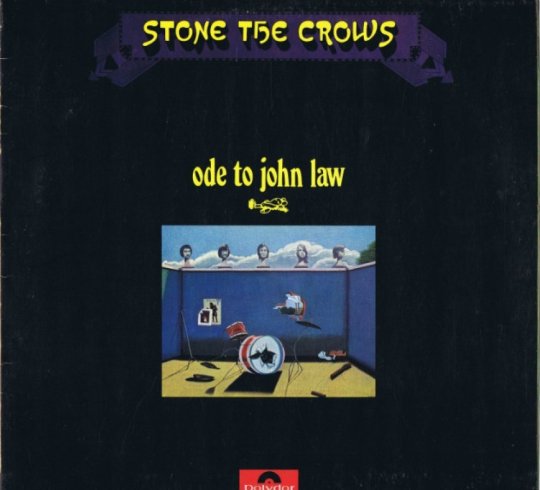
10:21 PM EDT April 22, 2024:
Stone The Crows - "Mad Dog And Englishman"
From the album Ode To John Law
(October 1970)
Last song scrobbled from iTunes at Last.fm
From the second album by the Scottish blues band.
0 notes
Text
JJ MAYBANK ! ⊹₊ ✰ ⋆





fics !
feast day [18+]
no one has ever wanted to go down on you. jj intends to rectify that.
indulge [18+]
john b only had one rule for jj; jj could not, under any circumstances, touch his sister. unfortunately for john b, jj has never shied away from breaking the rules.
hate the club
after your breakup with jj, you go through the motions as you try to navigate your life with him no longer part of it. (based on the song “hate the club” by kehlani)
hush [18+]
jj has to keep you quiet while your older brother's in the next room.
f&mu [18+]
it was the law of the jungle — kooks and pogues rarely got along — and this proved true for you and jj. however, that didn't stop the two of you from showing each other just how deep that hatred ran. (based on the song "f&mu" by kehlani)
wound up [18+]
you've had a bad week and jj makes you feel better.
dinner date
jj comes home late when you two have a date night planned and he tries to make it up to you.
cute drunk
jj takes care of you when you're drunk.
scored [18+]
jj cheers you up after your favourite football team loses their first game in the world cup.
reflections [18+]
jj surprises you when you two go on a romantic trip for the weekend.
role reversal [18+]
typically, jj is the one in control in bed. this time, however, you take the reigns.
a taste of both worlds [18+]
jj and rafe both find out that you've been seeing the other behind their backs. what are they supposed to do now?
safe haven [18+]
jj has an outburst at the chateau after a long and trying day, and you, his secret girlfriend, come to quell his rage.
pogue princess [18+]
jj gets into a fight with rafe while defending you. you go off at him because he's always so reckless with his life, and it leads jj to confess something you never would have expected.
can i [18+]
the more you drown in each other, the harder it is for you and jj to respect the boundary that is 'friends with benefits.' (based on the song "can i" by kehlani)
i'll go anywhere you go
your best friend jj gives you a token to show you how much he treasures you.
wet [18+]
shower sex with jj after a stressful day.
melt
snapshots of your swoon-worthy relationship with jj (based on the song “melt” by kehlani)
feature me [18+]
your breakup with rafe leaves you single and alone on valentine's day. you run into jj at a bar, and things get heated. (based on the song "feature me" by flo)
greedy [18+]
an ode to breeding kink!jj.
dangerous games [18+]
jj refuses to take the bait when you give him a tempting offer. you both agree on a compromise, but you're left pleasantly surprised with how things turn out.
birthday boy [18+]
you wake jj up on his birthday.
stake your claim [18+]
jj isn’t happy when he finds out you’ve been sleeping with other people on the island, so he’s sure to set the record straight. you’re his, and his only.
in between [18+]
best friends since the first grade, it was only inevitable that you and jj would fall for each other. however, when a single night suddenly changes things between you, you’re both left wondering if you ever should’ve tried to cross the line at all.

fic events !
obx week '23, kinktober '23

blurbs !
slightly overprotective bestfriend!jj
bestfriend!jj adoring your brown eyes
dirty talk with jj [18+]
riding jj [18+]
switch!jj [18+]
rough sex with jj [18+]
dad!jj and your daughter surprise you for mother’s day
jj wakes up to find you and your daughter playing makeup together
stress relief [18+]
jj x touch starved!reader
find the rest in concepts, concepts (two)

headcanons !
pregnancy headcanons
best friend!jj pining headcanons

prompts !
“i can’t pull out when your legs are wrapped around me like that.” [18+]
“first one to cum loses.” [18+]
“what’s wrong? why’d you stop?” + “nothing’s wrong. i just wanted to take a second to admire how beautiful you are.” [18+]
“i’ll be gentle, baby. don’t worry.” [18+]
“if i have to pull over, you’ll be walking funny for the next week.” [18+]

tag !
#jj maybank
#jj maybank#jj maybank imagine#jj maybank smut#jj maybank x reader#outer banks#outer banks smut#obx#obx smut#jj maybank fluff
2K notes
·
View notes
Text
Sci Fi/Fantasy Men Round 1 Masterpost
All polls are now up!
Ben Browder vs Mark Goddard
Jonathan Harris vs Richard Biggs
Jeff Conaway vs Rene Auberjonois
Lionel Jeffries vs Alan Napier
Paul McGann vs William Forward
Bill Paxton vs David Boreanaz
Jonathan Frakes vs Kerwin Matthews
Kurt Russell vs Jason Isaacs
Sam J Jones vs William Shatner
Michael O'Hare vs Edward James Olmos
Walter Koenig vs Frazer Hines
Edward Van Sloan vs Peter Cushing
William Russell vs Anthony Stewart Head
Alex Winter vs Michael J Fox
Brent Spiner vs Lance Henriksen
Jerry O'Connell vs Scott Bakula
Harrison Ford vs John Phillip Law
Christopher Lee vs Kiefer Sutherland
Adam West vs Danny John-Jules
Bruce Campbell vs Ted Raimi
Avery Brooks vs Ken Marshall
Vincent Price vs Dwight Frye
Michael Dorn vs Jerry Doyle
Gary Conway vs Andre the Giant
Cary Elwes vs Michael York
Charlton Heston vs Leslie Nielsen
Arnold Schwarzenegger vs Rutger Hauer
Dean Jones vs Ernie Hudson
Alec Guinness vs David Warner
Jeffrey Combs vs Peter Weller
Keanu Reeves vs Keir Dullea
Christopher Lloyd vs Malcolm McDowell
Dean Cain vs Christopher Reeve
Peter MacNicol vs Warwick Davis
Alexander Siddig vs Gareth Thomas
Clancy Brown vs Patrick Stewart
Patrick Swayze vs Bruce Willis
Cesar Romero vs Colin Baker
Haruo Nakajima vs Duncan Regehr
Ray Bolger vs Dick Van Dyke
Chris Sarandon vs Wesley Snipes
Patrick Troughton vs Jason Miller
Mandy Patinkin vs Jason Carter
Milos Kopecky vs Georges Melies
Michael Keaton vs Tony Todd
James Spader vs Brendan Fraser
Michael Shanks vs Oded Fehr
James Doohan vs Ricardo Montalban
Will Smith vs David Duchovny
Jeff Goldblum vs Donald Sutherland
Kevin McCarthy vs Leonard Nimoy
Harold Ramis vs Bill Pullman
Claude Rains vs Fredric March
Peter Davison vs Garrett Wang
Kyle McLachlan vs Nicholas Lea
Doug Jones vs Vladimir Korenev
Karl Urban vs Harry Hamlin
Tom Baker vs David Tomlinson
Buster Crabbe vs Billy Dee Williams
Patrick McGoohan vs Ed Wasser
George Takei vs Guy Williams
Paul Darrow vs Bruce Boxleitner
Brad Dourif vs Christopher Walken
Andrew Robinson vs Armin Shimerman
Nicol Williamson vs Sam Neill
David Bowie vs Joe Morton
Peter Capaldi vs Alan Rickman
Mark Hamill vs Rick Moranis
Arnold Vosloo vs Boris Karloff
Peter Jurasik vs Roger Delgado
Andreas Katsulas vs Craig Charles
Stephen Furst vs LeVar Burton
Richard Dean Anderson vs Laurence Fishburne
Tim Russ vs Colm Meaney
Colin Clive vs Tim Curry
Val Kilmer vs DeForest Kelley
James Stewart vs Conrad Veidt
Gene Wilder vs Bela Lugosi
Raul Julia vs John De Lancie
Nicholas Courtney vs Mitch Pileggi vs Rod Serling
50 notes
·
View notes
Text

Walking home from school just before her 10th birthday, Tura Luna Pascual Yamaguchi (Tura Satana) was reportedly gang raped by five men. According to Tura, her attackers were never prosecuted, and it was rumored that the judge had been paid off. She reports that this prompted her to learn martial arts, such as aikido and karate. Over the next 15 years, Satana tracked down each rapist and exacted revenge. "I made a vow to myself that I would someday, somehow get even with all of them," she said years later. "They never knew who I was until I told them." Around this time, she formed a gang, "the Angeles," with Italian, Jewish, and Polish girls from her neighborhood. In an interview with Psychotronic Video, Satana said, "We had leather motorcycle jackets, jeans and boots...and we kicked butt." Because of frequent delinquency, she was sent to reform school. When she was 13, her parents arranged her marriage to 17-year-old John Satana in Hernando, Mississippi, which lasted nine months.
Satana moved to Los Angeles and by age 15, using fake identification to hide the fact she was a minor, began burlesque dancing. She was hired to perform at the Trocadero nightclub on the Sunset Strip, and became a photographic model for, among others, silent screen comic Harold Lloyd, whose photos of her appear in "Harold Lloyd's Hollywood Nudes in 3-D."
Satana returned to Chicago to live with her parents and started dancing at the Club Rendevouz in Calumet City, where she was known as Galatea, "the Statue that Came to Life." She was offered a raise to become a stripper.
"I started out as an interpretive dancer, but I was offered more money if I took my clothes off, so I did. I started dancing at the age of 13 years old. I became a professional dancer at the age of 15 years old. If the owners of the clubs I had worked in ever knew that I was only 15, I think that they would have had a heart attack."
After singer Elvis Presley saw Satana perform at Chicago's Follies Theater, the two began a romantic relationship that some reports say ended in a marriage proposal she declined (though she reportedly kept the ring). Satana eventually became a successful exotic dancer, traveling from city to city. She credited Lloyd with giving her the confidence to pursue a career in show business: "I saw myself as an ugly child. Mr. Lloyd said, 'You have such a symmetrical face. The camera loves your face...You should be seen.'"
Satana's acting debut role was a cameo as Suzette Wong, a Parisian prostitute in the film "Irma la Douce" (1963), which starred Jack Lemmon and Shirley MacLaine. Her next role was as a dancer in "Who's Been Sleeping in My Bed?" (1963), which starred Dean Martin and Elizabeth Montgomery; Soon after, Satana appeared in the television shows "Burke's Law" and "The Man from U.N.C.L.E." Satana then starred as Varla in the 1965 Russ Meyer film "Faster, Pussycat! Kill! Kill!"—a very aggressive and sexual female character for which she did all of her own stunts and fight scenes. Renowned film critic Richard Corliss called her performance "the most honest, maybe the one honest portrayal in the Meyer canon and certainly the scariest." Originally titled "The Leather Girls", the film is an ode to female violence, based on a concept created by Meyer and screenwriter Jack Moran. Both felt at her first audition that Satana was "definitely Varla." The film was shot on location in the desert outside Los Angeles during days when the weather was more than 100 degrees Fahrenheit and freezing nights, with Satana clashing regularly with teenage co-star Susan Bernard due to Bernard's mother's reportedly disruptive behavior on the set. Meyer said Satana was "extremely capable. She knew how to handle herself. Don't f*ck with her! And if you have to f*ck her, do it well! She might turn on you!"
Satana was responsible for adding key elements to the visual style and energy of the production, including her costume, makeup, usage of martial arts, dialogue and the use of spinning tires in the death scene of the main male character. She came up with many of the film's best lines. At one point the gas station attendant was ogling her extraordinary cleavage while confessing to a desire to see America. Varla replied "You won't find it down there, Columbus!" Meyer cited Satana as the primary reason for the film's lasting fame. "She and I made the movie," said Meyer. Meyer reportedly later regretted not using Satana in subsequent productions.
"I took a lot of my anger that had been stored inside of me for many years and let it loose. I helped to create the character Varla and helped to make her someone that many women would love to be like."
Santana legally owned her likeness and image. So, whenever Russ Meyer wanted to change the artwork or rerelease "Faster, Pussycat! Kill! Kill!," he had to get her permission and sometimes pay her all over again. (Wikipedia/IMDb)
295 notes
·
View notes
Text
Intertwined Hearts / Intertwined Fates
Gods I am currently so obsessed with noblewoman Essatha and urchin Amon AU I shake it like a ragdoll between my teeth I love it I love it I love it arf arf
------------
Was this real? Of all the places that life could lead him, how cruel the humour if it held any sort of intention within its grasp. Splendid the luxury; how it made him feel sick with wanting, and with that wanting sick of himself for having the audacity to want at all.
Lady Essätha had no shortage in her kindness. If not for how early and unsuspecting this was all, he would have believed himself a charity case. For show: maybe; but for to better her own self-image would be more like it. This concept too would have run into its doubts, however. Every glance at her came with a great difficulty not to see the poetic version everyone drew so endearingly of her. She was it seemed every bit as was sung and said of her: generous, considerate, thoughtful and wise.
And I am a fool for staring, Amon Clermont thought bitterly. She was something of class and refinement; something far beyond the realm of his thoughts. He didn’t deserve to close his eyes and think of her so softly; or the way the light shone from her eyes whilst she smiled at him.
How long had he been here on her property now? Nor more than a week, and he could feel the disaster of John Keats and Fanny Brawne burrowing into every detail of his life. She was like a flame, and he the moth. He was not so clever and imaginative as the late author, but oh, Bright Star she was. There was an understanding in his heart now, how men could buckle and break to write such passionate odes.
It was all circumstantial. He reminded himself this again and again as he stepped into the mother-in-law suit on the Meduza estate grounds. Proving to her hospitality again and again, when he had held doubt on the very idea of staying in her home, she had finally convinced him of at least taking the extra dwelling unit. More importantly: it gave him some much needed distance between his crazed thoughts, and of her, though he tried not to admit it to himself. The smell of her fragrance lingering in the air of the manor; the sound of her moving throughout the hallways, her laughter; Gods to yearn for something so maddening like a boyish crush and a madman’s obsession.
There was a possibility that his time tied to Essätha Meduza could lead to his death. But what better fate to die, then? He had nothing, and she provided him with all humanely needs and all desires he gently attempted to rebuke. And there was her of course; her mostly importantly. The way she fidgeted her fingers, pulled back her hair, turned her eyes away as though shy when their gazes caught and lingered to long-
Pity him, he must be blind. Seeing things he shouldn’t, definitely. Amon gave a shake of his head, laughing at himself harshly as he moved about the room to undress. He opened the dresser (when was the last time he’d gotten to use one of these?) and gathered out some attire to wear to bed. There was no running water to this unit, but he had bathed and brushed his teeth in the main house before mulling down the walkway to the smaller house. Amenities on top of amenities, he was becoming spoiled.
Grunting, Amon tossed back the sheets and comforters to make space for himself in the mattress bedding. He took a great delight in the plush mattress; though Lady Essätha warned him that it was old and likely lumpy. It felt heavenly enough for him, and he took up the covers to shield himself from the chill of the night. Leaning over to where he’d left the lantern bedside that he’d walked down with, he blew out the lick of flame, and turned over to rest.
The world danced behind his eyelids as sleep swiftly overtook him. Nestled in warm bedding, full from a grand feast for dinner; all his dreams and thoughts were plentiful fantasies. All the comforts he had been missing out on for so long; all the literature at his fingertips, the access to humanity he’d been rejecting for so long.
Then of course, there was her. The glow of her in any lighting; it mattered not the sun or moon, the candlelight or magical baubles. It flowed through her, along her, beside her; filled her like an ethereal glow. She was the light, and it beckoned to her welcomingly. It came home to her readily; and brightened her eyes, her face, her smile-
A rapping at the door abruptly shattered him into awareness. At first he thought he had imagined it. Then Amon thought better of it; wearily remembering the hostile intentions of the murderous assassin. They would not come knocking in the middle of the night, no; but what if it was the Warden, or one of the temple healers. What if something had become of Lady Essätha?
Amon rolled quickly out of bed just as the second knock timidly rapped upon the door. He blinked at the blurry darkness that was his room, stumbling around the bedposts. There was so little moonlight on this night, and he could hardly see a damn thing. Tripping over one of his boots at the end of the bed, he growled to himself with annoyance as he finally made it to the doorway to tug the handle open.
I must still be dreaming.
Like Heaven’s Gates had opened before the very doorway, Lady Essätha stood awkwardly, her arms wrapped over her bosom in the chilled night air. Though he had grown accustom to the visible light catching off the golden hues of her iris like a predator stalking the night, her gaze was like a beacon in the night, guiding in warmth.
“Lady Essätha?” He drowsily grunted with shock. “Did something happen? Are you alright?”
The noblewoman reached up, pushing strands of curly black hair from her face. Her expression was naked with a kind of vulnerability he only ever saw at the Temple of Torm, when they had been admitted for healing after he’d saved her from the attempt on her life. Everywhere else, she had managed to hold a cool demeanor of strength and refinement. She was unshakable in that way.
“I’m sorry to have woken you at such an hour, Amon,” she rasped.
Amon. He loved the way she said his name. It lifted his spirits; how she curled it just right, announced it in such a way that gave it meaning and life and vibrancy. Not Mister Clermont, but Amon.
Call me anything, and I’ll answer to it, milady.
“It’s no trouble at all, Madame,” he answered with a rough clearing of his throat, “how can I be of service to you?”
She rubbed her elbows uneasily, dropping her gaze from his. Her entire body folded inward with doubt.
“I shouldn’t be bothering you-”
“Upon my mother’s name, milady, you are not causing me bother in the least. Is there anything that I can do for you?”
With a sigh, the woman’s shoulders sagged. “Would it… be alright if I slept here, tonight? I can’t seem to garner and rest. Every little noise sounds like someone’s in my room.”
Her throat flexed. Amon could still see the distinct impression of the rope that had at one point been tightened there, attempting to suffocate the life out of her. His own throat swallowed heavily, burdened by the reminder that still remained there.
“Of course, ma’am. This is your house, after all.”
Essätha lifted her eyes to gaze up at him with relieved fondness. “Thank you- but this is your space while you are here. I don’t want to intrude.”
“Not at all,” he quickly remarked, stepping aside as he gestured with a respectable bow. “Please do come in: the night is chilly, I wouldn’t want you to catch cold.”
Her eyes were grateful as she tentatively stepped into the small dwelling space. “I’ll take the armchair-”
“The bed is most certainly yours, milady.”
“I promised this room to you; the bed is yours,” the noblelady insisted as he quietly closed the door after her.
“Madame: respectfully, I have slept on much less comfortable things than an armchair. I’ll be alright.”
To his great astonishment, she jutted out a finger at him, her voice stern: “I will take the floor, then, if you must take the armchair.”
“That is a waste of a bed milady,” Amon countered, slightly exasperated.
Though it was too dark for him to see it, her cheeks inflamed with color. “Why do we not just share in the bed, then? It is large enough for two people.”
He knew she could see him blushing; with her remarkable vision that adjusted to even this inky black. Amon swallowed thickly as his heart leapt in his throat; enthralled with the idea. One that, he knew, he should be taking no interest in.
“I- That would be indecent, madame. I’m not worthy-”
“Amon,” say it again, he prayed; latching on to her every breath and word; “This is not a matter of philosophy, nor class; this is simply about rest and impartial equality. You were granted this space as your own; therefore, the bed is rightfully yours. However I will bend in this matter to share with you the bed, since I know that you are far too much a chivalrous gentleman and wouldn’t allow a lady sharing the same space as you to be less than comfortable. We can share in the bed.”
The matter-of-fact way that she said it, well, how could he refuse her? He should; he needed to, but he didn’t wish to. There was a thrill in his body; tingling from nerve end to nerve end. The very idea of her pressed so close to him while they rested, it made him feel a giddy restlessness of joy in his heart that he wished he could vomit out. He needed to be rid of it; this longing. It was unhealthy. It would lead nowhere.
“… Fine. Fine, but I can lay at the end of the bed-”
“Don’t be ridiculous,” Essätha snorted, making her way to the bedside. She climbed in with ease beneath the layers of fabric, and patted the adjacent side as she glimpsed up at him.
Join her? Now? His heart was pounding; sweat beading on his brow.
With an aching lightness in his chest, Amon shuffled around the other side of the bed; his eyes having adjusted better to the dark. He sank down at first, giving her time to change her mind, but she was already ahead of him; pulling back the sheets on his side, smoothing out the bedding cover. Her mass of black curls flopped into the pillow, burying herself in like it was a Queen’s comfort.
Slow as a snail, Amon took a seat on the mattress. One by one, he raised a leg to shimmy beneath the blankets. Lady Essätha huffed softly at his sluggish delay; tugging up the covers like a shroud before he had even laid back.
“Goodnight, Amon.”
Feeling inadequate and stupefied, Amon inclined back into the mattress, immediately turning his back to her. He couldn’t look at her. He couldn’t bare to. He feared that his own passionate desire would be plain on his face.
“Goodnight, Lady Essätha.”
“I told you before my dear: you can call me just Essätha, or Essie.”
“Of course, milady.”
She sighed on the other side of the bed, and it sounded sad. He hated that sound, but couldn’t make any sense on why it sounded that way. The framework of the bed creaked and bounced slightly as she apparently rolled over, curling herself up into a ball.
He allowed himself a single glimpse over his shoulder, seeing nothing but the thickness of her locks and her body rolled up in a balled up indistinguishable shape beneath the sheets. It didn’t take his thoughts much though to fill in the gaps: the soft, suppleness of her skin; aglow with the rich autumn tones. The gentle valley of her chest rising and falling, the curves of her hips, the line of her throat as her head tipped back-
Clamping down on his thoughts with an bear’s iron trap, Amon turned his head over. His lips were white; pressed together firmly as he bit the inside of his cheek. He was being incredibly indecent; daring to think of her so boldly when she was right there. Gentle and funny and sweet and right there. Like fate teasing him. Or how her voice so boldly challenged him; had him biting his tongue and finding no fault in how she approached him with an answer before he could dissuade her.
It would be over soon enough. He would wake and she would not be there; like the dream he believed it to be. Or he would wake and she would not be there, having fled from his side as she should. He was hardly a prize to be won, in status or appearance with his hideous scars. She was just lonely, and frightened. How could she not be, after what she’d been through?
And he would not take advantage of her fears. He would not abuse her kindness. She was here because of her night terrors, and he would respectfully be humbled by her finding security in his presence. Nothing more.
Eventually, his eyes fell closed. Sleep this time was dreamless; almost in a knowing that the reality he sought to ignore couldn’t be matched by a fantasy. To have her so close to him was far more than an urchin like he deserved. A nobody. A cast out. A failure on his family name; a would-be murder, a mess, a disaster.
When night fell to dawn, and he blinked in the morning light to stir to the world, he thought that maybe he was still asleep. It must be a pillow in his arms; it had to be a pillow.
But Lady Essätha groggily hummed in her sleeping state, curling herself bodily into him.
He wanted her. Not sinfully; though he may be a sinner. He wanted this casual comfort; the connection of human touch so peaceful and so long forgotten. Exploring bodies in carnal lust was easy to come by; a welcome lull to a deeper kind of loneliness. This though; blissfully content, was fulfilling in every way he could ever want day by day.
How on earth had they come to this though? She in his arms, her legs tangled with his, the heat of her breath wafting against his chest?
Tentative; fearful he would wake her and she would headbutt him right in the face, he nuzzled his face into her lush ebony curls as he knew he shouldn’t. She smelled of morning dew on marigold’s bloom; like the freshness of the cotton sheets and the ozone in the air before rainfall. There was a sweet hint of vanilla on her skin, and Gods, she was soft against him; loose and relaxed with trust and faith. Her skin as warm as a summer day, the sound of her breathing muffled against him as she shifted as though to get closer; to climb into his ribcage.
Let her go, his mind demanded. Get out before it becomes too much. Before you’re pulled in any further. The loss will destroy you otherwise.
She slept so serenely now. He could recall her restless nature even now at the Temple; how she’d been struggling against invisible nightmares and horrors that gripped her. How could be possibly refuse her a moment of tranquility, even if it was with himself? Yes it was selfish to take any joy in this moment; in a moment not warranted for him, but it wasn’t just for him, was it? She had come to him asking for his presence; wanting of this feeling of protection she felt assured he offered.
The noblewoman sighed, rubbing her cheek just beneath his collarbone. A stillness took over him bodily; hoping she did not wake and scramble away from him. Not yet; just give him a moment more to pretend, to craft a memory so vivid from this moment that he might yet be able to find comfort within it long past his time here.
Amon gave a muted thanks to the Gods, and clutched her closer; swearing her felt a reflexive tightening of her own arms around him as he pressed his face into her locks. He peered wearily at the rising sun filtering in through the curtains, knowing that all too soon it would rouse her completely from her slumber and they would have to unweave from this nest they made together.
Gods help him, he prayed he could find a way to learn how to unweave his heartstrings from her unknowing grasp one day too, before he lost. Before leaving was such agony that he couldn’t bare it. Before he settled down here, watching her, wanting her, and witnessing her grow with someone else yet being unable to live with the idea of never seeing her again.
Maybe his father had been right about him all along.
He was just a pathetic boy, with a weak heart.
#qhost story#OTP: Essamon#Essatha Meduza#Amon Illiad#Amon Clermont#softly written#you know that man is PINING so hard no matter the au#a fucking miserable fucking man when without his essie#big stupid wet eyes greedily devouring her affectionate nature#i want her i want her i want her yeah we know u idiot!!
3 notes
·
View notes
Text
ROUND TWO !!!!

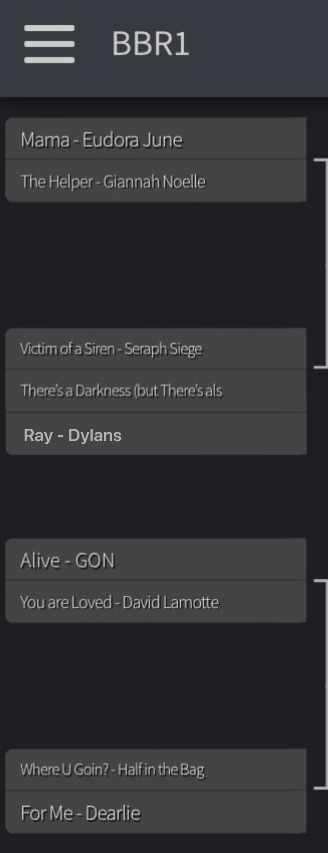
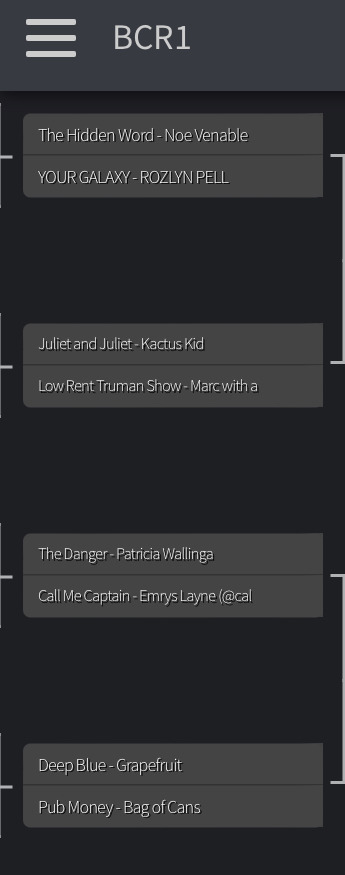

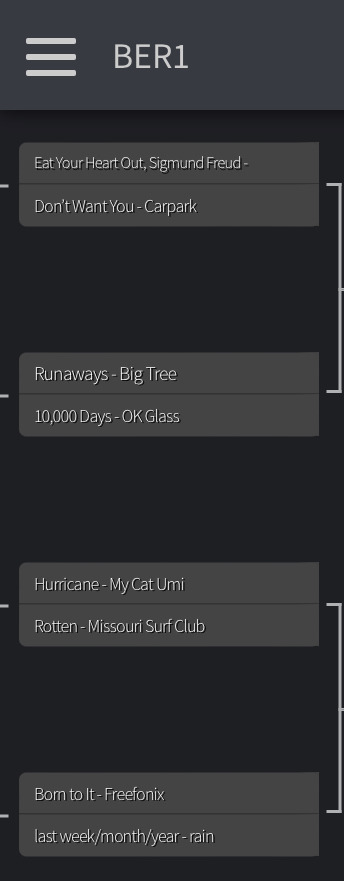


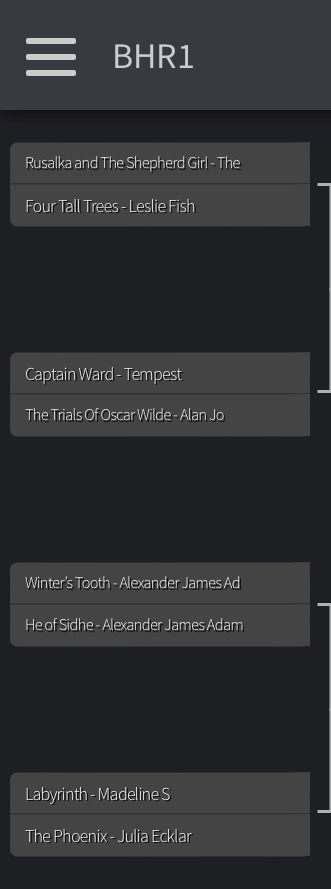

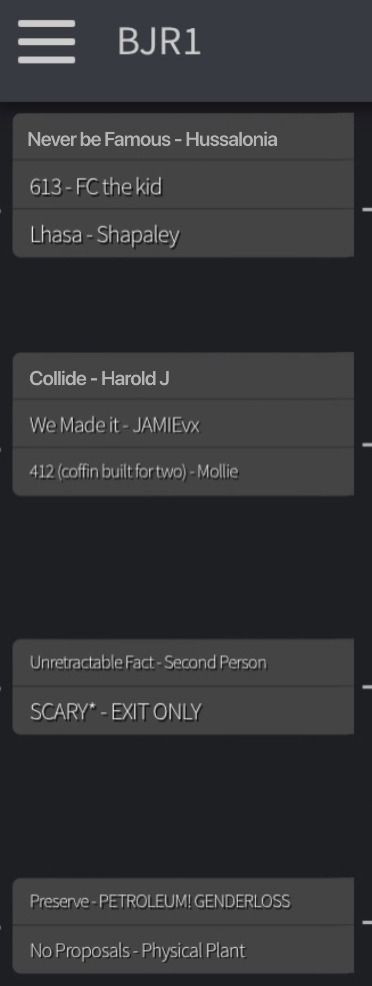






A
Keep Away - Isane Driver VS. Pulp Friction - Fool Heavy
Scatterbrain - Casual Tees VS. Sad Hit Song- V is for Villians
Patches - Jawbreaker Reunion VS. Animal Rites - John Congleton & The Nighty Nites
New Dance - DEERPEOPLE VS. Maple Leaf Etc - Maxshh
B
Mama - Eudora June VS. The Helper - Giannah Noelle
Victim of a Siren - Seraph Siege VS. There's a Darkness (but There's also a Light) - The Wild VS. Ray - Dylans
Alive - GON VS. You are Loved - David Lamotte TIE
Where U Goin? - Half in the Bag VS. For Me - Dearlie
C
The Hidden Word - Noe Venable VS. Echo in the Hills - Carrie Elkin VS. YOUR GALAXY - ROZLYN PELL
Juliet and Juliet -Kactus Kid VS. Low Rent Truman Show - Marc with a C
The Danger - Patricia Wallinga VS. Call Me Captain - Emrys Layne (@callmecapt) VS. Deep Blue - Grapefruit
D
PIANO GAMES - Hazma Notes VS. Worst in the World - Uncle Outrage
Cheese (original mix) -Cheese VS. Hokutoshichisei no Ichiya- Akiko lkuina
There'll be Someone at My Funeral Who Doesn’t Want to Be There - Sammy J VS. The Crayon Song - Class Of 3000
TECVM CIRCVMAMBVLARE NOLO - John Linnel VS. Imagination - Niel innes VS. Me and Nikolai - Pale Young Gentlemen
E
Eat Your Heart Out, Sigmund Freud - Mollie Maxwell VS. Don't Want You -Carpark
Runaways - Big Tree VS. 10,000 Days - OK Glass
Hurricane - My Cat Umi VS. Rotten - Missouri Surf Club
Born to it - Freefonix VS. last week/month/year - rain
F
Pointillize - Raccoon Fink VS. execute - ninty
Better Red Than Dead - KELChip VS. Ego -Powderpaint
... - subeteanatanoseidesu VS. Nighttime (I fall asleep) - Sam X
GOTH BITCH DUB - 621 gecs VS. To.Get.Her - Nixis
G
Dusk and Dawn - Das Fi VS. Between You and Me - Clementine Werchola
Monmon Fanmoran - Mochitsune VS. Can Graze the Roof Bring you Back to Childhood? - Anomaly Vector TIE
Memories - Jens East (Ft. Lotta Rasva) VS. Moongrains with Lyrics feat. Gumi A - Anonaly Vector VS. Ode to Janey Lou- FOE
The Dreaming- Marquis of Vaudevill VS. Best Friend - Taitoki
H
Rusalka and The Shepherd Girl - The Forgetmenauts VS. Four Tall Trees - Leslie Fish
Captain Ward - Tempest VS. The Trials Of Oscar Wilde - Alan John
Winter's Tooth - Alexander James Adam VS. He of Sidhe - Alexander James Adam
Labyrinth - Madeline S VS. The Phoenix - Julia Ecklar
I
Liar and the Hound - Beneath Eden VS. Bodysuit -FlooringCo
Pause Button - Particle Devotion VS. On a Walk - Fort Womb VS. Death is a Girl - Skippocalyptic
52 Pickup - Z. VS. 山谷澗 - Mysterain小雨樂隊 VS. Pub Money - Bag of Cans
J
Never be Famous - Hussalonia VS. 613 - FC the kid VS. Lhasa - Shapaley
Collide - Harold J VS. We Made it - JAMIEvx VS. 412 (coffin built for two) - Mollie Maxwell
Unretractable Fact - Second Person VS. SCARY* - EXIT ONLY
Preserve - PETROLEUM! GENDERLOSS VS. No Proposals - Physical Plant
K
Maneater- Blue Eyed Blondes VS. la somnambule - La Femme Pendu
Center Stage - Howard Martin VS. Gears of the Atom Man - Angels of Liberty TIE
Wake Up Girl - Skeeter Truck VS. Dark Rip - Teen Girl Scientist Monthly
Trust Me - Time Crash VS. Not Yet - Leo and the Little Things
L
Grace - Raelle VS. Animal- Xisco Feijoó
Hyperphantasia - Fearful Earful VS. Tonight Eternity Alone - Rene Clause
Cardigan Sweater - Jasmine Kennedy VS. Milá má - Nahore VS. Side A -Alohaha
The Binding Of isaac - Schmekel VS. Slip! - Bright Orange
M
Boy who Blocked the Sun - Demi the Daredevil VS. Rainy Day Georgia - Jayne Trimble VS. Burn it Down with Math - Deuce of Gears
Haircut Song - Shannon Moser VS. Reunion - Brent Spiner & Maude Maggart
Small Parts of Something Much Larger - Suns VS. Sunshine and Lollipops 2020 - Sad Snack
Say What You Want - Growth Spurt VS. Mirëmëngies - Edona Vatoc
N
Have You Ever Seen a Duck, Like, in Real Life? - Lisa the Beauty Queen VS. Housekeeper- Faun Fables
Caroline - Espers VS. Tales of the Phantom Ship - Nathan Landis Funk
Lotus eaters - Jessica Law VS. Raising the Dead! - Jessica Law VS. Autism Murder Memorial - Fit to Work
Blow Up the Moon - Feel Spectres VS. All For Me Grog! - Spud Bugs
O
Reclaim - Porch Cat VS. Orpheus on Ice - The Small Calamities VS. Violin Concerto in the Key of Crippling Regret - The Small Calamities
Homme Offer Knee - Ben Below VS. Hold My Heart - The Dune Sea
Each Time She Calls - Jessie Gosling VS. flexible guy - clown residue
Howard - Demo- Mother Aiden VS. Blooming Strangely - Ginger & Pear
P
恐竜あげみざわ★ - Kyouruu Friends VS. 星の旅人- Sayaka Senbong & Yumiri Hanamori
The End of the World - Fred Deakin VS. 運命は※ Love You - チームDEKAI
Ultimate Performance of Abandoned Magic Boxes ~ Racks of Junk - KR. Palto47 VS. 薔薇は美しく散る x 輪舞 revolution - okurigi66
297回の試行 - Image44 VS. They'll Make a Monster Out of You - Freefonix
#obscure song tournament#bracket#poll related#music poll#not polls#PRAYING for less ties this round.#but I think there might be MORE somehow cos less people are voting as time goes on#so it gets easier to tie </3
10 notes
·
View notes
Text
My Bio
Age: In my early twenties
Name: Can’t tell you
Birth Date: December 14, 2002
Favorite Adult Animation Shows: Solar Opposites, Robotomy, Rick and Morty, Adventure Time, South Park, Regular Show, Aqua Teen Hunger Force, Triptank, Lucy, Disenchantment, Futurama, The Simpsons, The Brak Show, Metalpacolypse, Soace Ghost Ciast to Coast, Central Park, Bob’s Burgers, American Dad, Clerks, Duncanville, Great North, Housebroken
Favorite Superhero Shows: Invincible, Villains of Valley View, Koala Man, Miraculous, Lab Rats, PPG ‘98, Hamster and Gretel, Moon Girl and Devil Dinosaur, Danny Phantom, Super Friends, Justice League ‘01, DC Super Girls ‘18, Static Shock, Horrorbots, Spider-Man ‘17, Avengers: Earth’s Mightiest Heroes, Star Vs. The Forces of Evil, Kim Possible
Favorite Cartoon Network Shows: Amazing World of Gumball, Camp Lazlo, Grim Adventures of Billy and Mandy, Cow and Chicken, Johnny Bravo, Dexter’s Laboratory, Time Squad
Favorite Nickelodeon Shows: SpongeBob SquarePants, Santo Bugito, Invader Zim, My Life as a Teenage Robot, El Tigre, Wonder Park, Modern Life, ICarly, Victorious, Kenan and Kel, All That
Favorite Disney Shows: Amphibia, Owl House, Ghost and Molly McGee, Hailey’s On It, Kiff, Star Darlings, Phineas and Ferb, Milo Murphy’s Law, Hannah Montana, Good Luck Charlie, Kickin It, Lab Rats
Favorite Discovery Family Shows: MLP ‘10, Aquabats Super Show
Favorite Streaming Shows: Centuarworld, Glitter Force Doki Doki
Favorite Food: Steak, Fries, Burgers, Chicken fingers, doughnuts, pancakes, bacon, fruit pastries, French toasts, fried chicken, turkey, duck, baked potatoes, hash browns, tacos, burritos, quesadillas, enchiladas, pork chops, ribs, Korean BBQ, Japanese chicken, steak fillet, Doritos, Ruffles, Cheetos, CC’s Chips, banana bread, Cheez-It’s Snaps, Goldfish
Favorite Sweets: Ice Cream, Hershey’s Chocolate, Reese’s, KitKat, Toffee, Cake, Cupcakes, Ice Cream Cakes, Skittles, Starburst, Cookies, Crumble, Cookie sandwiches, ice cream sandwiches, ice cream pops, animation character ice cream pops, sundaes, Nestle’s chocolate, Oreos
Favorite Fruits and Veggies: Asparagus, Carrots, broccoli, potatoes, strawberry, raspberry, lemon, like, grapes, apples, lettuce, cherry, bananas, coconut
Favorite drinks: Mountain Dew, Water, milk, root beer, coca-cola, tab’s, Mr. Pibbs, Pepsi, Dole’s juice brand, Fanta, Crush, Dr. Pepper, soda floats, Nesquick, smoothies
Favorite Actors: Patton Oswalt, Dan Stevens, Thomas Middleditch, John Gemberling, Will Forte, Charlie Day, Mike Sinterniklaass, Roger Craig Smith, Dan Mintz, Josh Gad, Dee Bradley Baker, Rob Schrab, Nate Corddry, Rob Corddry, Chris Pratt, Jack Black, Brian O’Halloran, Justin Feilbinger, John DiMaggio, Billy West, Oded Fehr, Michael Cusack, Zach Hadel, Phil LaMarr, Robbie Daymond, Kevin Smith, Jason Mewes, Matthew Lillard, Kevin Michael Richardson, John Mulaney, Antanio Banderas, Richard Steven Horvitz, Brandon Rogers, Sam Riegel, Jon Heder, Andy Daly, Zeno Robinson, James Marsden, Dana Snyder, Fred Tatasciore, Rob Paulsen
Favorite Actresses: Felicia Day, Mary Mack, Lacey Chabert, Brenda Song, Stephanie Sheh, Kate MiCucci, Riki Lindhome, Kari Wahlgren, Grey DeLisle, Jenny McCarthy, Melissa Fahn, Cristina Vee, Lana Condor, Sandra Oh, Odette Anaboe, Edie Mirman, Cathy Cavadini, Tara Strong, EG Daily, Olivia Olsen, Hynden Walch, Christina Hendricks, Libe Barer, Marieve Harrington, Sarah Nicole Robles, Kimberly Brooks, Dove Cameron, Sofia Carson, Vannessa Hudgens, Tika Sumpter, Reba Buhr, Erica Lindbeck, Vivian Nixon
Favorite Music Genres: Rock, Classic, Pop, orchestra, country, funk, techno, dubstep, heavy metal, Christian
Favorite Band: Ice Nine Kills, Adelitas Way, Bowling For Soup, Hansen, Disturbed, Slipknot, System of a Down, Hollywood Undead, Kiss, Queen, A Day to Remember, Thousand Foot Krunch, Nightwish, Evanescence, Seether, Imagine Dragons, Skillet, Newsboys, Simple Plan, Play, Nickelback, BTS, Blackpink, aespa, Black Eyes Peas
Favorite Singer: Rihanna, Taylor Swift, Nicki Minaj, P!nk, Katy Perry, David Quetta, Jennifer Lopez, Sia, Halsey, Kelsey Belleriny, AJ Michalka, Selena Gomez, Miley Cyrus, Demi Lovato, China Ann McClain, Ashley Tisdale, Avicci, Kelly Prickler, Aloe Blaccc, Lil Naxx, Post Malone, Eminem, Kelli Monologue, Paul Simon
Favorite Tv Genres: Animation Drama, dramedy, slapstick, comedy, animation, sci-if, romance, buddy, superhero animation, manga, anime
Favorite Movies: Hulk ‘03, Sky High, Kim Possible: So The Drama, Clerks, Incredibles, Ruby Gillman, Boy Who Cried Werewolf, Ratatouille, Alvin and the Chipmunk ‘07, Muppets in Space, Kickass, Belle, Elemental, Madagascar, Rugrats Go Wild, Wild Thorn Berrys Movie, Peanuts Franchise, Turning Red, Encanto, Emoji Movie, Ice Age Franchise (but not the Buck Wild one), G-Force, PPG Movie, Ben 10 2008 movie live action, South Park The Movie, PeeWee’s Big Adventure, Captain Underpants, Napoleon Dynamite, Jay and Silent Bob, Mallrats, Finding Nemo, Frozen, Super Mario Bros. Movie, Mitchells vs. Machines, Veggietales, Cars, 102 Dalmations, Romeo + Juliet, Small Soldiers, Godzilla vs King Kong, Godzilla: World of Monsters, Van Helsing, Hotel Transylvania, Secret Life of Pets, Sing 2
Favorite Wen Series: Annoying Orange, SMG4, Sunset Paradise, Helluva Boss, Hazbin Hotel, Meta Runner, Amazing Digital Circus, Eddsworld, Murder Drones, Most Popular Girls in School, Summer Camp, Summer Camp Island, Villanos
My Skills: Typing
My Weakness: I can’t draw
Favorite Monsters: Aliens, Kaijus, wereanimals, Kaijus weremonsters, robots, werewolves, vampires, mutants, giant beasts
6 notes
·
View notes
Text
An Ode to Yargı: Part 3
Note 1: This is part of a series: Part 1, Part 2
Note 2: I had written this during Season 1, but am just getting around to polishing and publishing it, so it mainly references events from Season 1.
Note 3: This is not meant to be an Ilgaz character study, but rather uses a few examples of Ilgaz’s behavior to help study audience biases. An excellent study of Ilgaz already exists here.
As mentioned in Part 1, I love that Yargı and its fans are teaching me a lot and subtly causing me to examine my own internalized ideologies. Something that I’ve been grappling with throughout season 1 of the show is the audience (and my) reception of Ilgaz, and whether we have metaphorical blind spots for good men. Ilgaz is the perfect foil to Ceylin: the quintessential classical good man who values integrity, honesty, and is committed and loving towards his wife and family. His masculinity has never been toxic, but rather comprised of stoicism, a strong sense of right and wrong, strength of character, and frankness. We know that he has an unwavering belief in the justice system and is well known for being a morally upright savcı (prosecutor). However, we can love him and still note his flaws, without making him out to be a toxic man.
Something I’ve realized throughout my time watching Yargı and keeping up with the Twitter fandom is that we seem to have a bigger blind spot for good men than we do for any other type of main character. I think this is due in huge part to the way many of us have been socialized and internalized the ideals that dictate our male-dominated patriarchal societies. When it comes to Yargı, we all know Ceylin to be a scrappy character with major trust issues when it comes to the justice system. We have no problem identifying her missteps, partially because she’s been written to make mistakes and then double down on them and partially because our societies have a pathological problem of women often being each other’s harshest critics. Pınar herself discusses the phenomenon and references John Berger’s book Ways of Seeing. With every misstep of Ceylin’s, especially when she hides something from Ilgaz, I find myself immediately thinking “ah Ceylin, ah!”. Similarly, the Yargı audience usually takes to twitter to discuss if Ceylin’s growth is happening too slowly, or that she has once again made a mistake. Don’t get me wrong, this discussion is honestly good and means Yargi has done its job because it leads the audience into constantly examining its views and beliefs.
However, I realized that we somehow don’t see a similar extent of reflection whenever Ilgaz hides something from Ceylin. I don’t catch myself thinking “ah Ilgaz, ah!”, or at least not until I rewatch the episode and give myself time to process. How come? Is it because Ilgaz has gained our trust? Because he’s the kind of guy who won’t lie in a testimony and is willing to marry a woman (that he potentially loves already) in order to avoid telling said lie yet still protect her from the consequences of her actions? Is it because we agree with Ilgaz and his motives? I’m not questioning whether Ilgaz is truly morally upright or not, nor am I criticizing Ilgaz as a character, but I am questioning if we have a blind spot for some of his habits because we see him as an ideal, values-driven, non-toxic, good™️ man. I admit that there are hardly any of his kind left on TV, so the law of supply/demand might also apply here. Not convinced? Here are some examples that came to mind for me:
Episode 3/Episode 12: Ilgaz doesn’t tell Ceylin about his father’s involvement in her father’s wrongful imprisonment until Engin forces him into a corner. Ilgaz has known for some time (since Ep. 3), and even temporarily succeeds in having Metin resign/retire, which doesn’t escape Ceylin’s notice (Ep. 9). Regardless, we empathize with his struggle to divulge this information to Ceylin because he is literally torn between the woman he has come to love and his father (who was literally about to shoot himself) through no fault of his own, so we understand why it’s difficult for him to reveal this truth. Sound familiar?
Episode 17: Ilgaz hides his parallel investigation into his first avukat-era client, Mithat bey, from Ceylin. He has a strong suspicion that his client Mithat is not innocent and confirms this via Eren. He is well aware of Ceylin’s view on the matter (that it’s not their job to investigate the truth, they’re not prosecutors, and that they can’t afford to determine the truth before taking on a client), and still chooses to investigate the matter secretly. I’m not criticizing his choice because it makes sense for Ilgaz, and also leads to a steamy scene that we all rejoiced over. However, it does seem familiar…
Episode 18: Ilgaz and Ceylin clash over the right approach to dealing with Galip’s case (involving the staple gun) because of its implications for Melike’s custody case. Ilgaz promises Ceylin he will do it her way, hiding his true intentions, which are then revealed retrospectively to Ceylin in court. Why did Ilgaz feel hiding this was necessary? Hasn’t Ceylin been his true partner so far? It’s possible that this part of the story was told in this way in order to trigger some suspense and uncertainty for the viewer, but to me this is another instance of Ilgaz hiding something from Ceylin because she doesn’t agree with his view or approach.
Episode 23: Ilgaz can tell something is up with Ceylin and tries to prompt her to share. When this fails, he digs through her trash, dissects his suspicions with Eren, and even tricks Yekta into helping him decode Ceylin’s secret envelope. Despite receiving good advice to just wait for Ceylin to share, Ilgaz searches her laptop without her knowledge, this time with police help, and finds out Ceylin knowingly sat on information about Yekta’s innocence in this particular case. This is yet another clear example of Ilgaz going his own way in secret when he doesn’t get Ceylin’s cooperation. Furthermore, while I saw many viewers defend Ilgaz’s actions here based on the fact that it’s unjust to arrest or imprison Yekta for a crime he didn’t commit, this was a blatant invasion of privacy to me, not to mention a display of lack of trust. Ceylin may be complicit in having Yekta wrongfully imprisoned, but that’s on her. That doesn’t make Ilgaz right.
Episode 28: The egg that’s been incubating since Episode 6 has finally hatched and Ilgaz knows about Metin and Cinar’s potential involvement in Zafer’s death and subsequent cover-up. At this point, Ilgaz has reprimanded Ceylin many times for hiding things. Remember when she briefly hid Parla’s involvement in money laundering from Aylin? Yet when Ilgaz is pushed to the brink by these new revelations, he ultimately can’t find the words to tell Ceylin the truth before the situation snowballs, and she finds out from Yekta of all people. Naturally, as viewers, we suffer with Ilgaz here and understand. Even as I write this, I’m questioning whether this was a true instance of hiding.
These examples obviously illustrate Ilgaz and Ceylin clashing over their interpretation of justice, because that is the central conflict between them. They also demonstrate that Ilgaz is a human, and though he gets really close to it, he is not perfect. He is flawed, just like Ceylin. However, even more interesting, these examples show us that when it comes to hiding things and operating in secret, Ilgaz and Ceylin actually share this tendency. Yet, we only seem to berate Ceylin about it. So what do you think? Do we have a blind spot for Ilgaz’s flaws? I would love to know your thoughts!
#yargı#yargi#ceylin x ilgaz#ilcey#ilgaz kaya#ceylin erguvan#ceylin erguvan kaya#ceylin kaya#turkish dizis#an ode
10 notes
·
View notes
Text
The 15 Year Battle For Dr. Martin Luther King, Jr. Day

Memorial March after assassination of Dr. Martin Luther King Jr.
On November 2, 1983, President Ronald Reagan signed the King Holiday Bill into law, designating the third Monday in January a federal holiday in observance of civil rights leader Dr. Martin Luther King, Jr. The legislation to recognize Martin Luther King Jr. Day was first introduced just four days after his assassination on April 4, 1968. Still, it would take 15 years of persistence by civil rights activists for the holiday to be approved by the federal government and an additional 17 years for it to be recognized in all 50 states. Today, it is the only federal holiday designated as a national day of service to encourage all Americans to volunteer and improve their communities.

Pinback button promoting Martin Luther King Day 1982. Collection of the Smithsonian National Museum of African American History and Culture
Despite the national fervor inspired by King's death, the bill to create a holiday in his honor languished for years with limited congressional support. However, Democratic Michigan Congressman, John Conyers, who first proposed the bill on April 8, 1968, was not deterred. He continued to reintroduce the legislation every year with the support of the Congressional Black Caucus, which Conyers helped found.
To me, [King] is the outstanding international leader of the 20th century without ever holding office. What he did — I doubt anyone else could have done. — Rep. John Conyers (D-Mich.) January 18, 2015
In 1979, on the 50th anniversary of King’s birth, the bill finally came to a vote in the House. However, even with a petition of 300,000 signatures in support, the backing of President Jimmy Carter, and testimonials from King’s widow, Coretta Scott King, the bill still was rejected by five votes in the House. Republican Missouri Congressman Gene Taylor led the opposition, which cited the costs of an additional federal holiday and traditions which exclude private citizens from receiving recognition with public holidays named in their honor.
Even though it failed to pass in the House, public support for the bill continued to grow, in no small part due to musician Stevie Wonder. The Motown singer and songwriter’s 1980 album “Hotter Than July” featured the song “Happy Birthday,” which served as an ode to King's vision and a rallying cry for recognition of his achievements with a national holiday.

Coretta Scott King and Stevie Wonder during M.L.K Gala at The Atlanta Civic Center in Atlanta Georgia, January 01, 1982. Photo by Rick Diamond/Getty Images
I just never understood / How a man who died for good / Could not have a day that would / Be set aside for his recognition ... in peace, our hearts will sing / Thanks to Martin Luther King — Stevie Wonder. "Happy Birthday" Hotter than July (1980)
Wonder continued to spread his message with regular appearances alongside Coretta Scott King at rallies. He also capped a four-month tour with a benefit concert on the National Mall, where King delivered his famous “I have a Dream” speech 18 years earlier.
When the bill again made it to the house floor in 1983, fifteen years after King’s murder, support was overwhelming. Working together, Coretta Scott King, the Congressional Black Caucus, and Stevie Wonder amassed a six million signature petition in favor of the holiday. The bill easily passed in the House with a vote of 338 to 90. However, when the bill moved onto the Senate, Republican North Carolina Senator, Jesse Helms attempted to dismiss the legislation by submitting documents alleging that the civil rights leader harbored ties to the communist party. Outraged by the personal attack on King's character, Democratic New York Congressman Daniel Patrick Moynihan threw the more than 300 page binder to the ground and stomped on what he described as a "packet of filth." After two days of debate, the bill passed in the Senate and President Ronald Regan reluctantly agreed to sign it into law.

In the presence of Coretta Scott King (2nd from left), President Ronald Reagan signs a bill making Martin Luther King Jr.'s birthday a national holiday. Photo by © CORBIS/Corbis via Getty Images
I would have preferred a non-holiday in King's honor but since they seem bent on making it a national holiday, I believe the symbolism of that day is important enough that I will sign that legislation when it reaches my desk. — President Ronald Regan, October 20, 1983
Despite the holiday’s federal recognition, statewide observance of Martin Luther King Jr. Day is far from uniform. Some states include additional holidays, which are celebrated concurrently with Martin Luther King Jr. Day. Arizona and New Hampshire, for example, celebrate “Civil Rights Day” and Wyoming celebrates “Wyoming Equality Day.” Other states, like Alabama and Mississippi, have combined the King holiday with “Robert E. Lee Day” to honor the birthday of Confederate General Robert E. Lee, who was born on January 19. However, Martin Luther King Day has been recognized in all 50 states since early 2000.
On August 23, 1994, the King Holiday and Service Act was signed into law by President Bill Clinton. Inspired by King’s life of service, Congressman John Lewis and former Senator Harris Wofford proposed the legislation to encourage Americans to find common causes and methods of improving their communities. In honor of Congressman Lewis’ initiative to make the Martin Luther King, Jr. holiday “a day on, not a day off” the National Museum of African American History and Culture has organized donation drives to those in need and partnered with corporations to provide music, film screenings and interactive activities to the public. If you are interested in giving back to your community this year, we encourage you to explore our website for volunteer opportunities or participate in the transcription of the Freedmen’s Bureau papers.**
**The Freedmen's Bureau Records
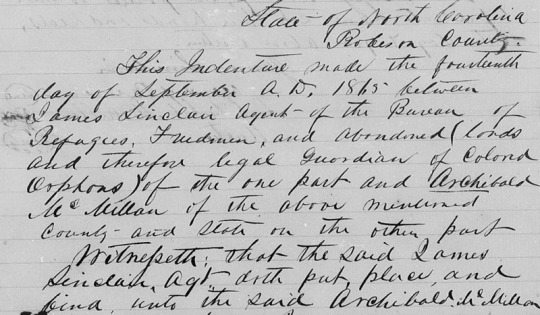
The Museum is focusing attention on the post-Civil War transition of enslaved people to freedom by making the records of the Freedmen’s Bureau accessible online.
The United States Bureau of Refugees, Freedmen, and Abandoned Lands, commonly known as the Freedmen's Bureau, was created by Congress in 1865 to assist in the political and social reconstruction of post-war Southern states and to help formerly enslaved people make the transition from slavery to freedom and citizenship. In the process, the Bureau created millions of records that contain the names of hundreds of thousands of formerly enslaved individuals and Southern white refugees.
Freedmen's Bureau Search Portal
The Freedmen’s Bureau Search Portal provides unprecedented opportunities for family historians and genealogists to search for their ancestors and for scholars to research a variety of topics related to slavery and Reconstruction in the Freedmen’s Bureau records. The portal makes possible for the first time the ability to research multiple sets of Freedmen’s Bureau data in one place, allowing users to search indexed data for specific names, places, and dates and transcribed data for topics, subjects, institutions, and any other words or phrases. Matches to search criteria will be highlighted in the results.
Freedmen’s Bureau Transcription Project
The Museum has collaborated with the Smithsonian Transcription Center to transcribe more than 1.7 million image files from the Freedmen’s Bureau records. The Transcription Center is a platform where digital volunteers can transcribe and review transcriptions of Smithsonian collections. The Freedmen’s Bureau Transcription Project is the largest crowd sourcing initiative ever sponsored by the Smithsonian.
Once completed, the Freedmen’s Bureau Transcription Project will allow full text searches that provide access to both images and transcriptions of the original records. Family historians, genealogists, students, and scholars around the world will have online access to these records. In addition, these transcribed records will be keyword searchable, reducing the effort required to find a person or topic. Transcribing these original documents will increase our understanding of the post-Civil War era and our knowledge of post-Emancipation family life.
History of the Freedmen's Bureau
Congress established the Bureau of Refugees, Freedmen and Abandoned Lands in 1865 to assist in the reconstruction of the South and to aid formerly enslaved individuals transition to freedom and citizenship. Administered by the War Department, the Bureau followed the department’s war-inspired record-keeping system. These handwritten records include letters, labor contracts, lists of food rations issued, indentures of apprenticeship, marriage and hospital registers and census lists. They provide a unique view into the lives of newly freed individuals and the social conditions of the South after the war.
The Bureau was responsible for providing assistance to four million formerly enslaved individuals and hundreds of thousands of impoverished Southern whites. The Bureau provided food, clothing, medical care, and legal representation; promoted education; helped legalize marriages; and assisted African American soldiers and sailors in securing back pay, enlistment bounties, and pensions. In addition, the Bureau promoted a system of labor contracts to replace the slavery system and tried to settle freedmen and women on abandoned or confiscated land. The Bureau was also responsible for protecting freedmen and women from intimidation and assaults by Southern whites. The Bureau set up offices in major cities in the 15 Southern and border states and the District of Columbia. Under-funded by Congress and opposed by President Andrew Johnson, the Bureau only operated between 1865 and 1872.
The Freedmen’s Bureau plays a key role in the Museum’s Slavery and Freedom and Defending Freedom, Defining Freedom: The Era of Segregation, 1877-1968 exhibitions. In these exhibitions, the Freedmen’s Bureau provides a backdrop against which we see African Americans resisting white efforts to deny them “life, liberty and the pursuit of happiness.” The Freedmen’s Bureau records are also featured in an Interactive exhibition in the Robert Frederick Smith Explore Your Family History Center on the Museum’s second floor.
The National Archives and Records Administration preserves the original Freedmen’s Bureau records.

The Bureau helped support schools like this one in New Bern, North Carolina, to educate newly freed children. Collection of the Smithsonian National Museum of African American History and Culture
You’ll find African American genealogists are quite excited about the Freedmen’s Bureau Project. Each Indexed document brings us closer to reclaiming our ancestral heritage and historical past. — Hollis Gentry, Museum Genealogy Specialist

Freedman's Village was located on what is now Arlington National Cemetery, Arlington, VA. Courtesy of Library of Congress, LC-USZ62-117892
Working on the Freedman’s Bureau Project has shed a light on the past for me that I never would’ve otherwise been able to experience. In working with these records, I gained a new understanding about how people lived. I hope the work we’ve done will be valuable for generations to come as people delve into their pasts. — Libby Herndon, Museum Volunteer
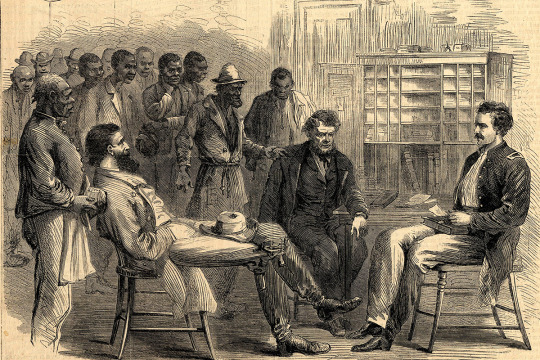
African Americans reported concerns and filed legal claims with agents at the Bureau’s field offices creating millions of handwritten documents. Courtesy of the New York Public Library Digital Collections
5 notes
·
View notes
Photo
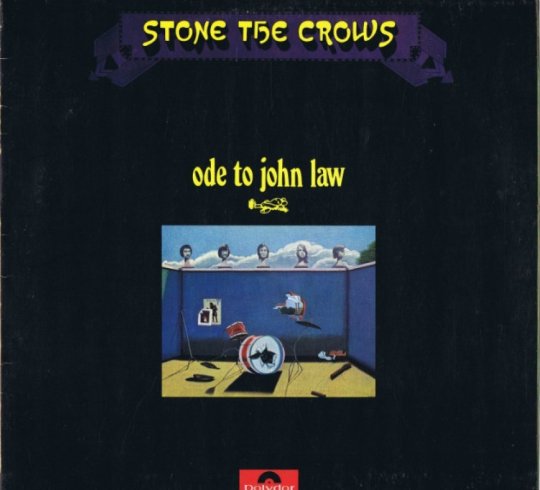
7:52 AM EDT April 19, 2024:
Stone The Crows -
"Things Are Getting Better - Single Version"
From the album Ode To John Law
(October 1970)
Last song scrobbled from iTunes at Last.fm
From the second album by the Scottish blues band.
0 notes
Text
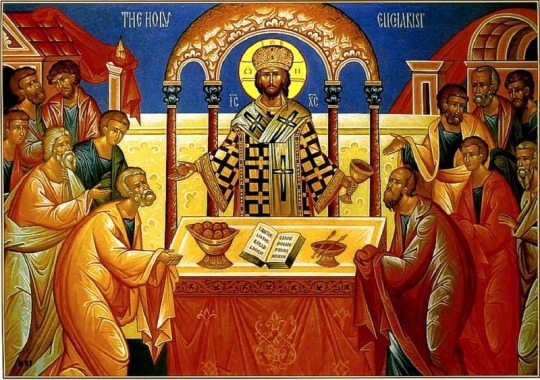
What counts is not observance of the Law but a cry de profundis, a change of heart, the truth of a personal relationship with Christ who has descended to the depths of my own personal hell. Those “who trusted in themselves that they were righteous, and despised others” (Lk 18.9) exclude themselves from the wedding Banquet. Moreover, they have a very specific idea of God: for them he is synonymous with vengeance.
In this penitential canon, which understandably wishes to remain on this side of Pascha, everything culminates in the mystery of the Cross, the antinomy of God incarnate and tortured, who—in the words of the Fifth Ecumenical Council—”suffered death in the flesh.” Not that it is a question of “expiation,” of a “sacrifice” of the Son to the Father. The theology of the Cross that we find in the Great Canon is fundamentally Johannine—the sort that predominates in the writings of the Fathers, particularly the Cappadocians. The reason why God descends into death is in order to give us life, to communicate to us his own life. Thy Body and thy Blood, O Word, thou hast offered at thy Crucifixion for the sake of all: thy Body to refashion me, thy Blood to wash me clean; and thou hast given up thy spirit, O Christ, to bring me to the Father (4.27). St Andrew’s theology of Holy Friday, which is already shot through with a paschal frisson—for, as the Fathers stress, the Cross is “life-giving”—culminates in the immediate prelude to Pascha; namely, a theology of Holy Saturday as the ultimate humiliation of Christ being turned into a victory over hell. When Christ dies, creation is seized with fear, but hell is destroyed: The creation was in anguish, seeing thee crucified. Mountains and rocks were split from fear, the earth quaked, and hell was despoiled (9.32).
At the heart of the Great Canon, as in most texts of the eighth century, are the remains of vast liturgical poems dating from almost two centuries earlier—the Kontakion and Ikos that are placed at the end of the sixth ode. In this particular Ikos, we hear the moans and groans of the devil as he sees Christ’s house of healing opened, and health flowing down from it upon Adam. It is he now who is in mortal danger, lamenting to his friends, “I am slain by the Man from Bethlehem, who is everywhere present and fills all things” (Ode 6, ikos). St Andrew, for his part, is much more discreet: O Creator, thou hast worked salvation in the midst of the earth, that we might be saved. Thou wast crucified of thine own will upon the tree; and Eden, closed till then, was opened (4.28). The tree that had become a tree of sorrows, as a consequence of Adam’s deviation, becomes again the Tree of Life, when the Living One incorporates it into himself by his voluntary death.
Christ’s side is pierced, the dawn of the Spirit breaks and, inseparable from it, that of the Church. May the Blood from thy side be to me a cleansing fount, and may the water that flows with it be a drink of forgiveness (4.29). According to the patristic interpretation that is already implicit in John, the water and blood mentioned here refer to baptism and the Eucharist. But more broadly, St Andrew has in mind the entire life of the Church as a mystery of the Crucified and Risen One, a combination of sacramental life and meditation on Scripture. For he adds: May I be purified by both, O Word, anointed and refreshed, having as chrism and drink thy words of life (ibid.). We have here an echo of the great Origenistic tradition according to which a veritable “incarnation” takes place in Scripture. As a chalice, O my Savior, the Church has been granted thy life-giving side, from which there flows down to us a two-fold stream of forgiveness and knowledge, representing the two covenants, the Old and the New (4.31). This short passage admirably evokes the relationship between the Church and her Lord, a relationship of sacramental and spiritual life, Scripture and the “mystery.” The Church does nothing other than gather and communicate the life that flows from the Crucified One. She is a chalice, a cup that overflows without end “for the life of the world” (Jn 6.52). The two Testaments are unified in the Eucharist, in the Risen One who resurrects us in turn.
Olivier Clement
“Song of Tears”
12 notes
·
View notes
Text
Submissions are now officially closed! Thank you to everyone who sent one in! In the end, we have a grand total of 163 different actors for the tournament.
The full list of actors can be found below. People who have been added since the last list was posted are all at the bottom.
I'll be getting to work on the match-ups; I'm gonna aim to hopefully have the polls start going out by the end of the week. I'll make another announcement before the first polls go up.
Until then, here's the list!
Bruce Campbell
Tom Baker
Leonard Nimoy
Alex Winter
Mandy Patinkin
Gene Wilder
Jeff Goldblum
Danny John-Jules
Ricardo Montalban
Miloš Kopecký
Tim Curry
William Russell
William Forward
Michael O'Hare
Richard Biggs
Ed Wasser
Michael J Fox
Alec Guinness
Keanu Reeves
Colm Meaney
Clancy Brown
Jeff Conaway
Haruo Nakajima
Paul Darrow
Peter Jurasik
Stephen Furst
Scott Bakula
Andreas Katsulas
René Auberjonois
Armin Shimerman
Donald Sutherland
Kurt Russell
Christopher Lloyd
Jerry Doyle
Fredric March
Alexander Siddig
Bill Pullman
Arnold Vosloo
Keir Dullea
Lionel Jeffries
Buster Crabbe
Boris Karloff
DeForest Kelley
Laurence Fishburne
Ray Bolger
Jeffrey Combs
Andrew Robinson
Michael Dorn
Peter MacNicol
Richard Dean Anderson
Kyle McLachlan
Sam Neill
Mark Hamill
LeVar Burton
James Spader
Peter Weller
John de Lancie
Bruce Boxleitner
Avery Brooks
Jonathan Frakes
Patrick Stewart
Patrick McGoohan
Charlton Heston
Arnold Schwarzenegger
Wesley Snipes
Billy Dee Williams
Bela Lugosi
Val Kilmer
David Bowie
Dick Van Dyke
Doug Jones
Oded Fehr
David Duchovny
Jerry O'Connell
Mitch Pileggi
Michael Shanks
Nicholas Lea
James Doohan
George Takei
Leslie Nielsen
Warwick Davis
Vladimir Korenev
Walter Koenig
Garrett Wang
Rutger Hauer
Rick Moranis
Will Smith
Harrison Ford
Gareth Thomas
William Shatner
Ben Browder
Claude Rains
Tim Russ
Colin Clive
Brent Spiner
Peter Davison
Michael York
Nicol Williamson
James Marsters
Frazer Hines
Nicholas Courtney
Cary Elwes
Chris Sarandon
Lance Henriksen
Bill Paxton
Christopher Reeve
Christopher Lee
Peter Cushing
Raul Julia
Brendan Fraser
Rod Serling
Paul McGann
Anthony Stewart Head
Karl Urban
James Stewart
Mark Goddard
Guy Williams
Alan Rickman
Gary Conway
Vincent Price
Edward James Olmos
John Philip Law
Kerwin Matthews
Patrick Troughton
Ken Marshall
Patrick Swayze
Peter Capaldi
Andre the Giant
Cesar Romero
David Boreanaz
Alan Napier
Roger Delgado
Georges Méliès
Harry Hamlin
Duncan Regehr
Joe Morton
Ernie Hudson
Bruce Willis
Conrad Veidt
Sam J Jones
Lani Tupu
Michael Keaton
Kevin McCarthy
Jason Carter
Brad Dourif
Colin Baker
Harold Ramis
Dean Jones
David Warner
David Tomlinson
Christopher Walken
Ted Raimi
Jonathan Harris
Jason Isaacs
Edward Van Sloan
Dwight Frye
Malcolm McDowell
Craig Charles
Jason Miller
Tony Todd
Dean Cain
Kiefer Sutherland
Adam West
#not a poll#announcements#sffantasy men full contestants list#adding an extra tag just to note I miscounted by one there are in fact *163* actors which is now updated in the post itself
28 notes
·
View notes
Text
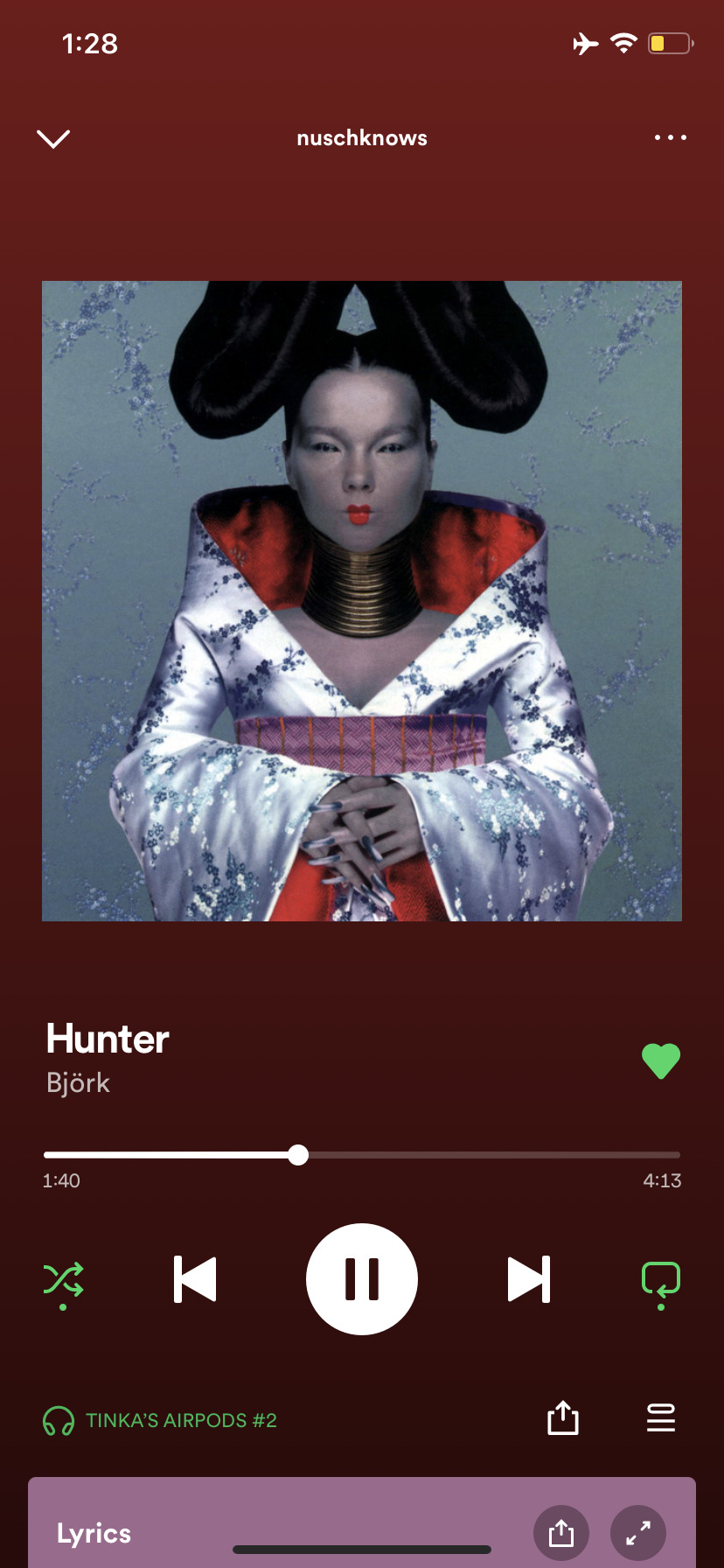




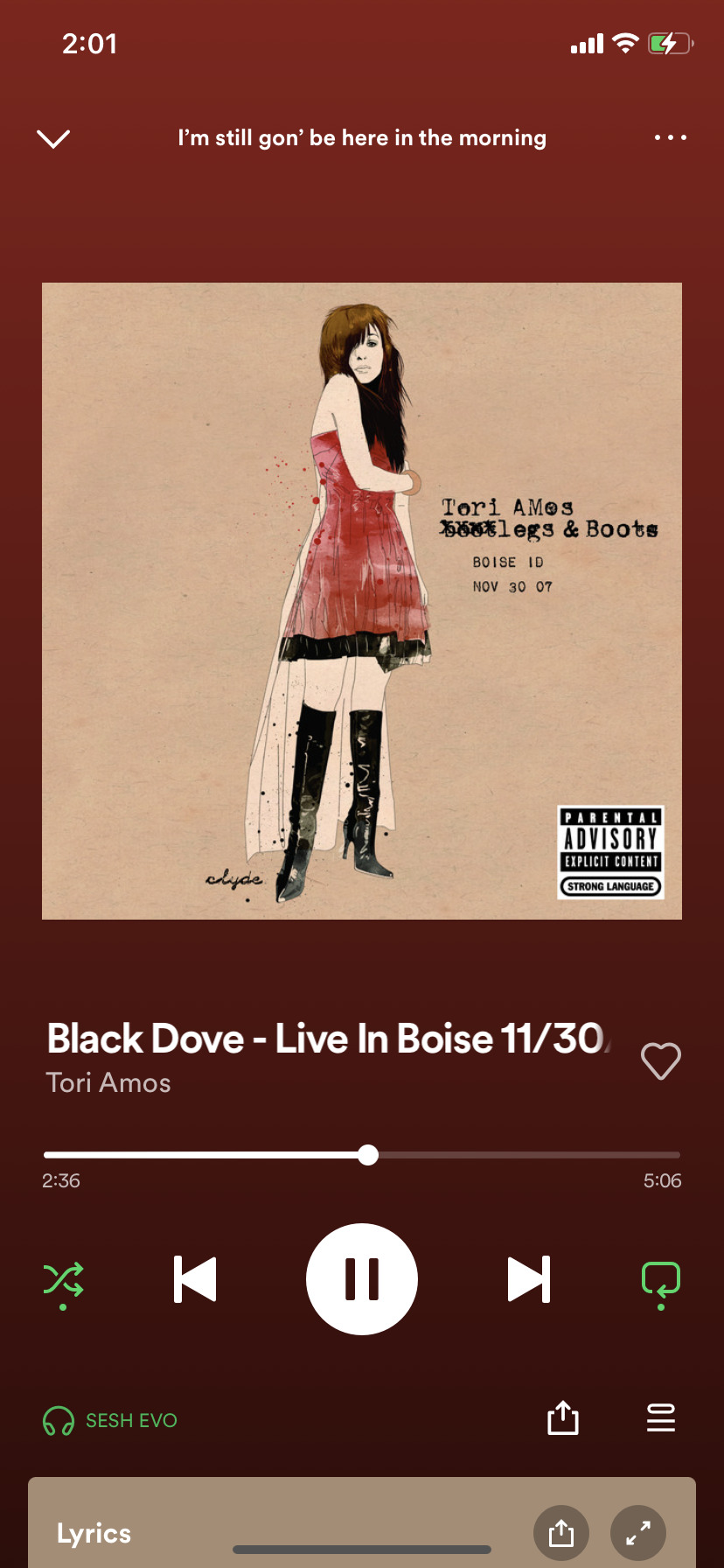

So you left me on my own to complete the mission
I'm the hunter
What are we gonna do?
We've opened the door, now it's all coming through
“Now there’s a few things we have to burn.”
And everyday I wore your face
So much time on the Other Side waiting for you to wake up
Even friends seem out to harm you
The way they make me feel is still way too real to believe
Running round in circles all day long
There’s a girl in cherry chapstick (ode to Pauline and dirty girl lipgloss)
Stella: big weekend, guys
The divine masculine (3 of cups/the world)
My eyes have seen you stand in your door
My eyes have seen you:
Turn and stare
Fix your hair
Move upstairs
Memorize your alleys
Well, we all have a face that we hide away forever and we take them out and show ourselves when everyone has gone; though we share so many secrets there are some we never tell
“When I pressed her for a reason she refused to even answer.”
Clear as shit I was not the issue.
The music is your only friend.
My mind is like a deadly disease*
God damn right you should be scared of me
I’m well-acquainted with villains that live in my head
“They beg me to write them.”
All the kids cry out “please stop you’re scaring me.”(finally got that one)
Can you co-direct and play the twins and adapt the main theme? I’ve conjured up..
I had big ideas, the kind you’d rather not share over the phone
Coordinated release*
Some were just hysterical scenes.
“If she says she can do it, then she can do it, she don’t make false claims.”(K shoutout)
I was always able to write my way out.
“The building’s emptied.”
Wake up to find out that you are the Eyes of the world
When all you wanted was to be
wanted
Wish you could go back and tell
yourself what you know now
Back then, I swore I was gonna marry him someday but I realized some bigger dreams of mine
a boy who changed his mind
And the dialing of the phone is no longer fun since you’ve been done with me and you don’t want to talk to me at all. Why did you not want to try? Why’d you take it all away?
She was a january girl, she never let on how insane it was in that tiny kinda scary house by the woods
Rick, john, sally, a connection named paul; holy law and money, their intentions are tall
A psychic hit me, told me we got shit to do
Virgos
All you sailors, all lifesavers, all you cruisers, all you fishermen
Go to sleep little earth
Just keep telling me it’ll turn out alright
Do you remember the first time? I can’t remember a worse time.
No I don’t care if you screw him just as long as you save a piece for me
Youre a liar and that’s the truth, you’re the curses through my teeth, you’re the laughter, you’re the obscene, you’re the boxer in the ring with brass knuckles underneath
I think I love you; I think I’m mad
Sooner or later you’re gonna break down and sing
The trial, were you scared? Well anyone facing eight Months in jail would be scared.



2 notes
·
View notes
Text
We are all Greeks. Cerámicas de Miquel Barceló
Seguramente resulta sorprendente o titular desta reseña sobre unha mostra de cerámicas do gran creador Miquel Barceló. Pero o propio artista denomina así a exposición:Barceló. Ceràmiques.Tots som grecs, tomando prestada esa afirmación do poeta romántico Percy Shelley. Os dous comparten a admiración polos eixos da cultura na Grecia antiga. Barceló é un pintor matérico, mesmo lle agrada procurar a terceira dimensión na pintura. Tamén o é cando traballa a arxila?
Lito Caramés

Miquel Barceló na Pedrera
Barceló. Ceràmiques.Tots som grecs. La Pedrera
O Attic shape! Fair attitude! with brede / Of marble men and maidens overwrought, / With forest branches and the trodden weed; / Thou, silent form! dost tease us out of thought / As doth eternity: Cold Pastoral! / When old age shall this generation waste, / Thou shalt remain, in midst of other woe / Than ours, a friend to man, to whom thou say’st, / “Beauty is truth, truth beauty, – that is all / Ye know on earth, and all ye need to know.” (John Keats, Ode on a Grecian Urn, 1819).
Quizais sorprenda bastante comezar os comentarios sobre unha exposición temporal de cerámica, instalada no edificio gaudiniano de La Pedrera, reproducindo a derradeira estrofa do poema do escritor romántico John Keats (1795-1822) Ode on a Grecian Urn. É certo que hai unha ligazón: o poeta mostra a súa admiración por unha urna grega. Keats foi un romántico arquetípico, xa pola súa escrita, xa pola súa biografía, morreu con 25 anos. Como outros románticos británicos, e doutras latitudes, Keats acabou sendo un gran admirador da cultura clásica, grecolatina. A súa devoción polos modelos estéticos que se presumía dirixían a vida da Grecia antiga e mais da Roma imperial provén, como non!, dos traballos e loitas dun home fundamental na historia da arte europea (aínda cando el non era artista). Johann Joachim Winckelmann (1717-1768) é o responsable principal de que en Europa xermolase un novo concepto estético no século XVIII e que se perpetuou pola seguinte centuria, e mesmo ata a actualidade. Como reacción fronte ao Rococó, Winckelmann propuxo (e mesmo inventou) volver aos harmónicos canons que trufaran la Grecia clásica, e que xa se recuperaran perante os tempos do Renacemento. Nestes tempos nos que é aconsellable ter como fundamento de análise a concepción de que os acontecementos históricos sempre son froito de accións colectivas, soa moi forte afirmar que unha soa persoa (Winckelmann) sexa a responsable de cambios tan fondos e duradeiros nas filias estéticas. Para quen queira coñecer os avatares biográficos de Johann Winckelmann (e para moitas outras cousas), recoméndase o libro Peregrinos de la Belleza Viajeros por Italia y Grecia, da entusiasta escritora María Belmonte. Calquera persoa que teña interese polas culturas mediterráneas debería coñecer e ler este magnífico libro.
Keats, romántico e namorado desas estéticas clásicas que, poucos anos antes espallara en artigos e estudos Winckelmann. E a admiración que leva ao poeta a compor estrofas cantando a aquela urna de máis de 2000 anos de antigüidade, tamén o empurra a rematar a súa oda coa rotunda afirmación (que é o compendio do clasicismo): Beauty is truth, truth beauty, – that is all / Ye know on earth, and all ye need to know. E a beleza está neses restos gregos que se poden admirar polas xeografías europeas. Percy B. Shelley, outro importante poeta romántico británico (a tríada seguramente son estes dous citados e mais Lord Byron, que tamén andaba canda eles por xeografías europeas), que tamén admiraba as serenas e cheas de naturalidade estéticas clásicas -ao ler os versos do seu amigo Keats- escribiu We are all Greeks. Our laws, our literature, our religions, our arts have their root in Greece. Unha declaración de amor a todas as creacións executadas na Grecia antiga.

Barceló. Sin título, 1998
Todos somos gregos ( We are all Greeks) a vella sentenza de Shelley é empregada agora por Miquel Barceló para dar título á exposición que nestes meses primeiros de 2024 enche o piso Principal da Casa Milà, La Pedrera. Unha mostra que xunta os traballos de Barceló perante 30 anos en cerámica, principalmente cerámica; traballos con barros e arxilas. Poida que non sexan os traballos máis coñecidos do autor da decoración da capela do Santísimo, na catedral de Palma de Mallorca, pero leva anos e anos dedicando tempo e esforzos á creatividade con eses materiais tan básicos, tan nas raizames de calquera cultura. Quizais por iso, tamén, Barceló afirma que la ceràmica és la mare de la pintura. Pintura amplificada. Se Barceló titula a súa propia antolóxica con esa declaración de Shelley é porque el comparte a reverencia polos logros estéticos e conceptuais da Grecia antiga. Como balear sempre hai -na base de todas as súas actividades- un recoñecemento mediterráneo. Poida que sinta ben identificado coa cantiga de Joan Manuel Serrat.
Xa se sabe que Miquel Barceló, un dos artistas contemporáneos máis recoñecidos a nivel mundial, ten traballado moitos eidos plásticos. É pintor e escultor, pero tamén se lle coñece e moito polos seus traballos como debuxante e ilustrador. Só para Círculo de Lectores ten ilustrado varias obras literarias das máis emblemáticas de Occidente: La Divina Comedia, de Dante, por exemplo. A mostra Barceló. Ceràmiques. Tots som grecs xunta máis de 100 obras do artista, cerámicas que están acompañadas (e completadas) con pinturas, debuxos e bastantes cadernos nos que ía tomando notas; así como dous vídeos que axudan moito a comprender os xeitos de traballar de Barceló. A visita realízase de maneira cronolóxica, comezando polas súas primeiras cerámicas, alá polo ano 1984 e chegando ata o día de hoxe.
A exposición compleméntase con moitas actividades (faladoiros, concertos de música) pola cidade de Barcelona, e algunhas outras pola cidade de Palma, como a que se presenta na Fundació Toni Catany; trátase de fotografías que o excelso fotógrafo -Toni Catany- tirou de cerámicas e obras de Barceló. E tamén coa edición dun magnífico e interesante catálogo no que se poden ler artigos de estudosos das súas creacións, así como comentarios do propio artista sobre pezas concretas. Así a carón da vasilla Vase de Pêche, 1996, Barceló comenta: Probablement ces oevres avec hameçons sont à l’origine de parois de la chapelle à Palma. Pas à cause des hameçons mais de la manière dont les poissons sortent de la boue, de l’argile. C’est à ce moment-là que j’ai eu envie d’agradir le geste. L’argile devient peinture.
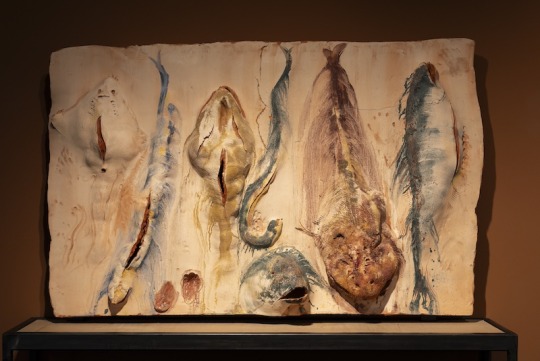
Barceló. Peixos, 2003
Barceló. Ceràmiques. Tots som grecs. Harmattan. Accións físicas, creating action
A orixe das cerámicas de Barceló (...) sitúase a mediados dos anos 1990 perante unha estancia do artista en África. O propio Barceló xa contou que estando no País Dogón, unha zona remota da república de Mali, África Occidental, en 1995, e despois de días con vendavais intensos que enchían todo de po, sendo imposible debuxar ou pintar, comezou a traballar co barro.(E. Juncosa, Una història de la matèria, comisario no catálogo da exposición).
O País Dogón é unha rexión situada aproximadamente no centro de Mali, preto da fronteira con Buekina Faso. É unha zona particular, onde viven as comunidades Dogón, e instalada en pleno sahel, a ancha franxa estremeira co propio deserto do Sáhara; un clima árido, tropical semidesértico. No inverno, cando as temperaturas son máis baixas (rondando os 20º) sopra o vento harmattan, un vento alisio do nordeste que sopra en dirección ao Golfo de Guinea, moi seco e forte, e mormente entre os meses de novembro e marzo. Ese vento que chega do Sáhara levanta moito po e provoca unha atmosfera molesta e abrancazada. Nesas condicións atopouse Miquel Barceló no inverno de 1994, que estaba pasando uns meses precisamente alí. Posteriormente volveu moitas veces. Ao non poder pintar nin debuxar porque todo se inzaba de area, obrigando a ter todo pechado, Barceló, para non estar sen facer nada, comezou a mirar que facían as mulleres (as responsables de elaborar os útiles de barro para usos domésticos). E dese xeito comezou a traballar o barro para logo pasar a facer algunha pezas concretas. Dese primeiro inverno (as primeiras pezas que coceu Barceló están agora expostas na Pedrera) o que máis destacan son as cabezas; cabezas bastas, primitivas -case caveiras humanas e de outros animais- que o artista elaborou seguindo os pasos que levaban centos de anos executando as mulleres dogón.
Posteriormente, xa en Mallorca, Barceló foi afondando nos coñecementos da artesanía dos oleiros, aos comezos quixo saber iso: as técnicas artesanais. A creación artística virá despois. As cerámicas de Barceló pódense entender como unha extensión da súa pintura. Visitar na Pedrera Barceló. Ceràmiques. Tots som grecs é asistir á celebración creadora deste artista matérico. Barceló nas súas pinturas máis coñecidas e en diversas épocas sempre aposta por introducir nos lenzos, nas pinturas moita materia; tense dito, e é doado comprobalo, que moitas pinturas de Barceló teñen tres dimensións: nalgunha que se pode ver agora na Pedrera o artista meteu por riba do lenzo tramas metálicas que lle permitisen precisamente iso: a terceira dimensión.

Barceló. Cossiol amb flor vermella, 2012
A cerámica é unha forma extrema de pintura -ten declarado Miquel Barceló- a min permitiume dar un salto e pasar do Neolítico ao século XXI. As cerámicas, por tanto, son parte importante da creatividade do autor da cúpula da sala XX das Nacións Unidas, confeccionada entre 2007 e 2008. Esa cúpula en teoría está pintada, pero pintada en relevos, con estalactitas, como unha cova na que habita a humanidade.
Como se pode apreciar nas numerosas obras expostas en Barceló. Ceràmiques. Tots som grecs, Barceló é un artista que aposta polo esforzo físico. Xa o fai coas pinturas. A imaxe típica de Barceló é se presente coa roupa chea de materia, xa pictórica, escultórica ou de arxila. É artista de acción. Na presentación da exposición Barceló declarou que a relación coa cerámica é física. Trabállase co corpo. Un partidario da creating action, da acción, da actividade fronte a calquera material. Máis aínda na cerámica que xa per se esixe o amasado, a preparación, o traballo no torno (ou manual). Barceló é un creador físico. Agora na Pedrera está instalado un vídeo moi revelador do que se está a dicir: Paso doble (2006). Paso doble foi un encargo que o festival de Teatro de Avignon lle fixo a Barceló, unha performance en toda regra. No vídeo -interesatísimo- vese ao propio Barceló e ao coreógrafo Josef Nadj que actúan sobre unha base de barro xa preparado que ten dúas partes, unha horizontal, no chan, e outra vertical, como unha parede de fondo. Perante máis de 40 minutos os dous artistas van atacando o barro coas súas mans, con todo o corpo, con ferramentas agrarias e de xardinería, todo para acabar convertendo aquelas superficies lisas de barro en paisaxes, faces e todo tipo de representación que se queira aceptar. Hai moita improvisación. O resultado é un xigantesco espectáculo; espectáculo físico. Barceló ten afirmado que, cando facían Paso Doble quedaban moi cansos.
Ese cansazo ten moito que ver cos xeitos “físicos” de traballar do artista, e tamén co seu respecto por todo o que sexa traballo manual; polas artesanías. Cando traballou arreo para inzar de decoración a capela do Santísimo da catedral de Palma, el mesmo declarou que estaba a traballar e a seguir as liñas que lle marcaban Antoni Gaudí, que xa fixera unha intervención nas ábsidas desa catedral, e mais dun dos axudantes fundamentais do arquitecto: Josep María Jujol, arquitecto e gran amante da natureza. Por iso agora as cerámicas de Barceló encaixan perfectamente no Principal de La Pedrera, o edificio emblemático de Gaudí e no que tamén traballou moito Jujol. Por outra parte, e seguindo coa artesanía, Barceló ten afirmado que viaxou polas xeografías españolas seguindo un libro de Llorens Artigas, o gran ceramista da segunda metado do século XX. Llorens Artigas -que rematou por ter un taller con varios fornos en Gallifa- estudou no Xapón e foi amigo e compañeiro de Joan Miró. As numerosas e diversas cerámicas de Miró (incluíndo os paneis que fixo para moitas institucións) son impensables sen as aprendizaxes de Llorens Artigas.

Barceló. Família, 2015
Agora na Pedrera pódese apreciar como o azar xoga un papel importante na creación das pezas do artista. El mesmo comenta que comeza unha peza pero non sabe ben cal será o resultado final. No proceso creativo está parte da orixinalidade. A carón da peza que leva por título Deserto Giallo (1999), Barceló escribe: El cos de les cabres i ases està fet amb trossos de lava. Pedres de lava recollides al Vesuvi. Evidentment, la lava pot sobreviure al forn de 12.110 graus. O que fixo o creador foi elaborar a peza no torno e, mentres estaba a arxila fresca, foi tirando con forza contra a cerámica pedras negras de lava, que agora se poden ver incrustadas, e posteriormente pintou os corpos dos animais. As pedras foron impactar onde o azar determinou.
Nun intre do percorrido polas salas chégase a unhas mesas onde se atopan vasillas negras. A cerámica negra ten moitos e moitos séculos de antigüidade. O que quizais non sabe Barceló é que no concello de Sober (sur de Lugo, Ribeira Sacra) na parroquia de Gundivós elabórase cerámica negra moi estilizada e elegante desde sempre; unha cerámica de alta calidade.
Para rematar a exposición Barceló. Ceràmiques. Tots som grecs Barceló instalou nun recuncho unhas cantas pezas que el mesmo titula Tótems. Trátase de ladrillos de grande dimensións (poida que de metro por metro), amoreados uns por riba de outros, e logo intervidos. Xa se sabe como “intervén” Barceló as pezas: atacándoas con¡as mans e ferramentas. Ao ver eses tótems con pezas esaxeradamente grandes a referencia ao Pop Art vén soa. Estará a transitar esas estéticas agora o artista balear?
Lito Caramés
EXPOSICIÓN: Barceló. Ceràmiques. Tots som grecs.
Fundació Catalunya-La Pedrera
ata o 30 de xuño de 2024
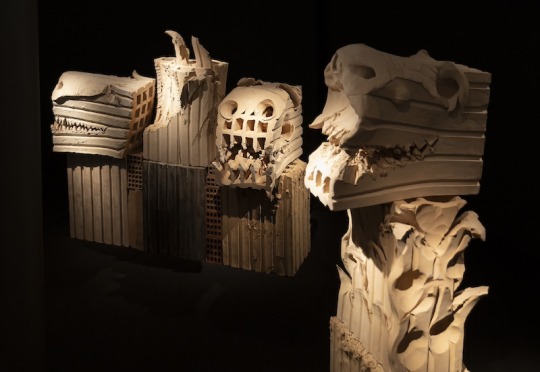
Barceló. Tótems, 2018
0 notes
Text
The Rigour of Angels: Human Nature and the Nature of Reality
“This is a participatory universe… Observer-participancy gives rise to information,” the visionary physicist John Archibald Wheeler wrote a generation before philosopher Iain McGilchrist asserted that the way we pay attention—the supreme participancy of consciousness in the universe—“renders the world what it is.”
It may be that consciousness evolved not so much to let the universe comprehend itself, as poetically inclined astrophysicists are fond of saying, but to keep us from being overwhelmed by the totality of a universe which we, as living functions of it, can never fully comprehend; to keep us from being crushed by the weight of a reality as vast as space and as deep as time, a whole so absolute and simultaneous that a mind can only hold it in disjointed parts across discreet moments.
These are the immense and intimate questions William Egginton takes up in The Rigour of Angels: Borges, Heisenberg, Kant, and the Ultimate Nature of Reality (public library)—an ambitious effort to trace “the capillaries of coherence flowing from the particular to the universal,” part ode to those who have caught glimpses of that elemental coherence we call truth and part elegy for our destiny as creatures doomed to glimpses only, for we are particles of the totality we yearn to see whole as we go on seeing through our instruments and our theories not the universe but ourselves.
Egginton traces the invisible threads of revelation between Zeno’s thought experiments and Kant’s cathedrals of logic, between Dante’s cosmogony and the discovery of cosmic microwave background radiation, between Plotinus and Heisenberg, in order to illuminate and celebrate how that collaborative tapestry of thought has shaped “our conceptions of beauty, science, and what we owe to each other in the brief time given to us in this universe.” At the centre of the book is the recognition that what we know about how the universe works is not a reflection of absolute truth but of our sensemaking—something William Blake intimated in his koan of a lyric that “the Eye altering alters all.” Egginton pulls back the curtain of perception:
“Is the saturated red of a Vermeer part of that ultimate reality? The soft fuzz of a peach’s skin? The exalted crescendo of a Beethoven symphony? If we can grasp that such powerful experiences require the active engagement of observers and listeners, is it not possible, likely even, that the other phenomena we encounter have a similar origin? When we do the opposite, we forget the role we have in creating our own reality.”
With an eye to Borges—a guiding spirit of the book, who understood that time is the substance we are made of, understood that we have dreamt up the world with our cult of reason but must live in it with the “tenuous and eternal crevices of unreason which tell us it is false”—Egginton considers the limits of observation, our sole lens on reality:
“A being who was truly, exclusively saturated in a present moment wouldn’t be able to observe anything at all. Observation, any observation, installs a minimal distance from what it observes, for the simple reason that for any observation to take place, one here and now must be related to another here and now, and that relation needs to be registered by some trace or connector between the two.”
Two centuries after Kierkegaard asserted that “the moment is not properly an atom of time but an atom of eternity,” he adds:
“The blur of the instant of change that is a logical prerequisite for stitching together any two moments in space-time inextricably inheres in the very reality being observed.
[…]
In a deep sense, then, the laws of physics, the laws that describe how things behave, are really the laws of our observations of how things behave.”
Heisenberg’s uncertainty principle—that pillar of quantum physics, which holds that you can know a particle’s position or its momentum, but never both at the same time—cast the challenge of coherence in spacetime into sharp relief, but it was the Platonic philosopher Plotinus who first took the paradox of simultaneity and made of it a model of eternity. Egginton writes:
“Plotinus didn’t conceive of eternity as an endless, boring extension of the present. Instead, he imagined eternity as everything, all existence, all space, and all time, captured at once, in the blink of an eye. Eternity wasn’t the endless expansion of time; it was the absolute negation of time. We humans experience things in time because we are limited and cannot fully grasp the absolute unity of all things. The time we inhabit, he taught, is nothing but the moving image of eternity, an insignificant second hand sweeping over the face of a vast, immobile clock, never grasping more than a fraction of its surface. However, we could be certain that this eternity existed. For, as Kant would also see a millennium and a half later, our very ability to experience any given moment in time logically necessitates the existence of a reality that transcends those moments, a greater unity that “upholds things, that they not fall asunder.”
Plotinus went on to inspire Saint Augustine’s “vision that would unite physics and ethics in a strange, new architecture of the cosmos and an ultimate vindication of human freedom.” Naturally, inevitably, the paradox of free will pulsates beneath Egginton’s inquiry—for, if Octavio Paz was right that “without freedom, what we call a person does not exist,” then without freedom there can also be no observer and without an observer there is no world to render real. A generation after Simone de Beauvoir examined how chance and choice converge to make us who we are, Egginton reflects:
“It is because I cannot take both roads and still be the same traveller that I imagine them and, in imagining them, and in choosing, am condemned to that very freedom that the godlike knowledge of a mechanistic universe seeks to absolve me of. We seek to render that godlike knowledge real; we contort our imagination and make myths out of math; we brew bubbling Kandinsky multiverses and grow gardens of infinitely forking paths. But the intimate rifts, the interstices of unreason that those models seek to obliterate, are indelible. They inhabit us. They make us what we are.”
Echoing Lewis Thomas’s lovely insistence that “we need a better word than chance” to account for how we went “all the way from a clone of archaebacteria, in just 3.7 billion years, to the B-Minor Mass and the Late Quartets,” he adds:
“As we steer a course through the river of our lives, we are affected by innumerable forces, the vast majority unknown to us. By some accounts this makes of our freedom an illusion, for how can we purport to freely choose when we can’t even see a fraction of the legion of influences acting on us, limiting our movements, sparking our appetites? The threat this picture poses to traditional notions of agency suggests a counternarrative. There must be some part of us that floats above the river, untouched by its waters and therefore utterly free and totally responsible for our every turn. But both these pictures are misleading, and for the same reason. Our freedom, and hence our responsibility for the choices we make, is neither a thing to look for in our material existence nor some ghostlike essence unmoored from that existence. Rather, it is a necessary postulate for a being who can imagine having chosen differently, the condition of the possibility of conceiving of that life as one possible path among many.”
Inseparable from the question of freedom is the nature of the imagination—that ultimate frontier of our freedom of thought. In a passage evocative of the poetic physicist Alan Lightman’s insight into the shared psychology of creativity in science and art, Egginton considers the fruits of that freedom:
“In a satisfying work of art, the ensemble of its elements conforms to its internal principle, the idea that guides it. Thus, when we come to the end of a mystery novel, the solution appears inevitable, although we couldn’t see it coming. Likewise, when we find a theoretical explanation for the seemingly random events of the natural world, we feel the same aesthetic satisfaction as with a well-wrought plot or a masterfully composed symphony: we thrill to the diversity of nature expressing the idea of its order, its inherent rigour. That guiding principle that we read in nature or in art appears to us its purpose. But just as the work of art ignites our aesthetic judgement only when its creator has erased the signs of artifice, so our understanding of the natural world is led by a silent conviction that the universe that unveils itself before our eyes works toward an end and purpose, one it expresses from the greatest cataclysms of galaxies down to the most intimate crevices of possible perception, and yet one that was never meant, never intended, never planned by angel, god, or human mind, other than our own.”
That purpose and meaning are not inherent to the universe but our own creation, that all of our reckonings with the nature of reality are a mirror we hold up to ourselves, is at the heart of The Rigour of Angels. Egginton reflects:
“No matter where we train our gaze on the starry skies above, we look inward toward the very origin of space and time. Thus freeing our minds from our senses, we find that the universe is, indeed, turned inside out.
[…]
We ultimately realise what we are striving for lies inside us; we find ourselves in the world and the world in ourselves.”
Complement with quantum pioneer Erwin Schrödinger, writing nearly a century ago, on the universe and the mystery of what we are and physicist Brian Greene on our cosmic search for meaning, then revisit Marie How’s poem “Singularity”—that magnificent quickening of thought and feeling, giving shape to the deepest human yearnings in a cosmos indifferent to our fate, insentient to our freedom.
Source: Maria Popova, themarginalian.org (15th October 2023)
#quote#love#life#time#meaning#existential musings#all eternal things#love in a time of...#intelligence quotients#depth perception#understanding beyond thought#essential thinking#perspective matters#universe and you#please be philosophical#this is how it goes#stands on its own#elisa english#elisaenglish
0 notes
Text
[TILT] The Goldilocks Rule
Goldilocks Rule naziv proizašao je iz bajke o Zlatokosi (Goldilocks) i tri medvjeda. Priča govori o djevojčici Zlatokosi koja se nađe u domu tri medvjeda. Gladna, prvo proba kašu tate medvjeda koja je prevruća. Zatim proba kašu mame medvjeda koja je prehladna. Na kraju proba kašu djeteta medvjeda koja je "taman". Umorna, prvo legne u krevet tate medvjeda koji je pretvrd. Zatim proba krevet mame medvjeda koji je premekan. U konačnici legne u krevet djeteta medvjeda koji je "taman". Baš kako treba biti. Idealan . Princip Zlatokose - Goldilocks rule - predstavlja idealnu opciju. "Taman" opciju. Predstavlja izbjegavanje ekstrema.
Princip Zlatokose primjenjuje se u brojnim znanstvenim i stručnim disciplinama. Od kognitivnih znanosti , medicini, teoriji komunikacija, statistici, itd.
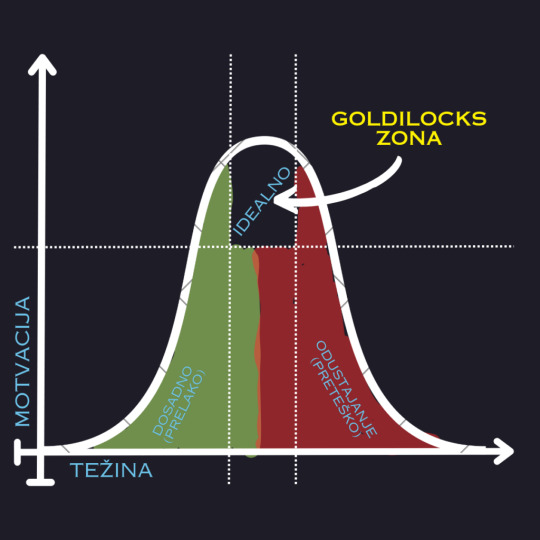
The Goldilocks rule kaže da su ljudi najviše motivirani kada je zadatak, koji moraju napraviti, malo iznad njihovih mogućnosti. Ako je ispod trenutnih mogućnosti, zadatak je pre lagan. Dosadan. Ako je iznad, zadatak je pretežak. U oba slučaju motivacija je niska i u padu. Ako je malo iznad trenutnih mogućnosti onda je u Goldilocks Zone.
Kako primijeniti Goldilocks Rule u svakodnevnom životu i radu? Svaki cilj koji zadajete sebi ili svojim djelatnicima mora biti malo "teži" od trenutnih mogućnosti. Mora zahtijevati malo više truda za savladavanje novih znanja ili rješavanje novog problema. Malo izvan comfort zone.
Znanstveni naziv za Goldilocks rule je Yerkes-Dodson Law. Nazvan po znanstvenicima koji su 1908 godine došli do otkrića empirijske veze između pritiska i rezultata .
Video materijali
Za one koji žele znati više
The Story of Goldilocks and the Three Bears, https://www.dltk-teach.com/rhymes/goldilocks_story.htm
Kidd C, Piantadosi ST, Aslin RN. The Goldilocks effect: human infants allocate attention to visual sequences that are neither too simple nor too complex. PLoS One. 2012;7(5):e36399. doi: 10.1371/journal.pone.0036399. Epub 2012 May 23. PMID: 22649492; PMCID: PMC3359326, https://www.ncbi.nlm.nih.gov/pmc/articles/PMC3359326/
Seamus J. Martin (2011) Oncogene-induced autophagy and the Goldilocks principle, Autophagy, 7:8, 922-923, DOI: 10.4161/auto.7.8.15821, https://www.tandfonline.com/doi/abs/10.4161/auto.7.8.15821
THE RELATION OF STRENGTH OF STIMULUS TO RAPIDITY OF HABIT-FORMATION, Robert M. Yerkes and John D. Dodson (1908), First published in Journal of Comparative Neurology and Psychology, 18, 459-482., https://psychclassics.yorku.ca/Yerkes/Law/
Read the full article
0 notes